Green birds are a diverse group of avian species that are found in many parts of the world. These birds range in size from tiny hummingbirds to large, majestic raptors.
As a group, they are incredibly beautiful and captivating to watch. With their bright, vibrant feathers and lively behavior, green birds are a delight to observe. They are also important in many ecosystems, playing vital roles in controlling insect populations and dispersing seeds.
In this article, we will explore the fascinating world of green birds and learn about their unique behaviors, habitats, and adaptations.
1. Parrots
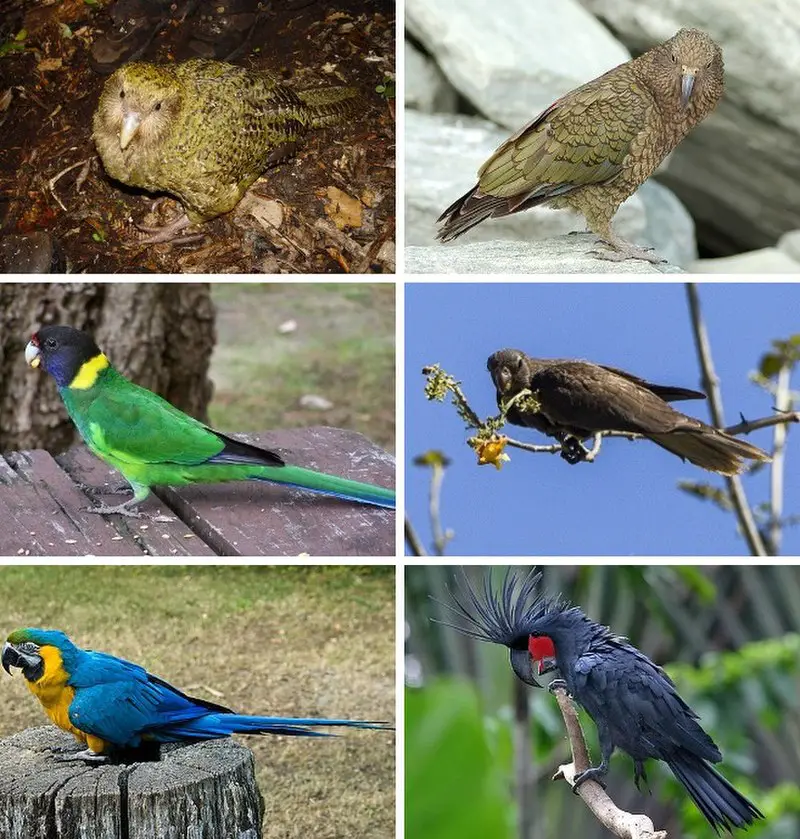
Parrots are a diverse group of birds, found in tropical and subtropical regions. They make up the order Psittaciformes, which is divided into three superfamilies: “true” parrots (Psittacoidea), cockatoos (Cacatuoidea) and New Zealand Parrots (Strigopoidea).
Many species have brightly colored feathers that can be red, yellow or blue. Their strong curved bills allow them to feed on fruits, nuts and seeds.
Parrot behavior ranges from playful to aggressive depending on their environment and socialization with humans.
Some even learn human words. As beloved pets they bring joy to many households around the world though it’s important for owners to understand how best to care for these intelligent creatures so as not to cause distress or harm.Scientific classification:
| Kingdom | Animalia |
| Phylum | Chordata |
| Class | Aves |
| Clade | Psittacopasserae |
| Order | Psittaciformes Wagler, 1830 |
2. Green Parakeet
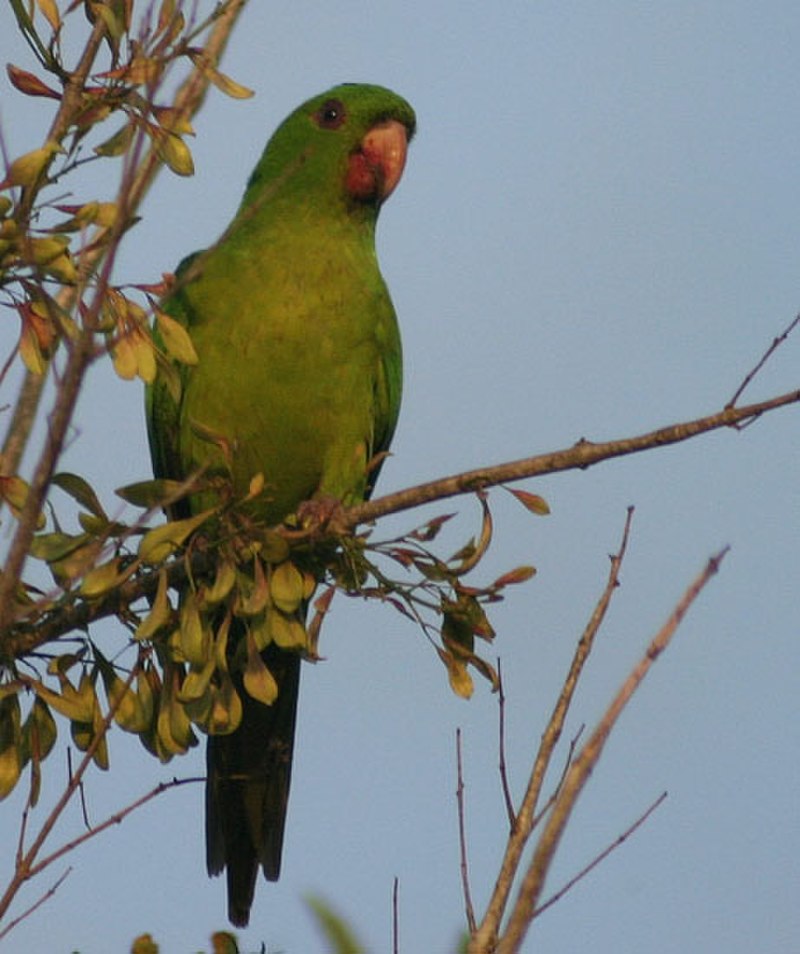
The green parakeet is a beautiful medium-sized bird, measuring up to 32 cm in length. It has distinctive bright green feathers and a yellow beak, making it truly stand out among other birds.
In the wild, these parrots primarily feed on seeds, various fruits and corn as well as live in scrubland or swampy areas across North and Central America stretching from Texas to Nicaragua.
Unfortunately they are sometimes considered crop pests due to their feeding habits.
Despite this behaviour however, the stunning colouration of these birds makes them an interesting addition to any landscape.Scientific classification:
| Kingdom | Animalia |
| Phylum | Chordata |
| Class | Aves |
| Order | Psittaciformes |
| Family | Psittacidae |
| Genus | Psittacara |
| Species | P. holochlorus |
3. Budgerigar
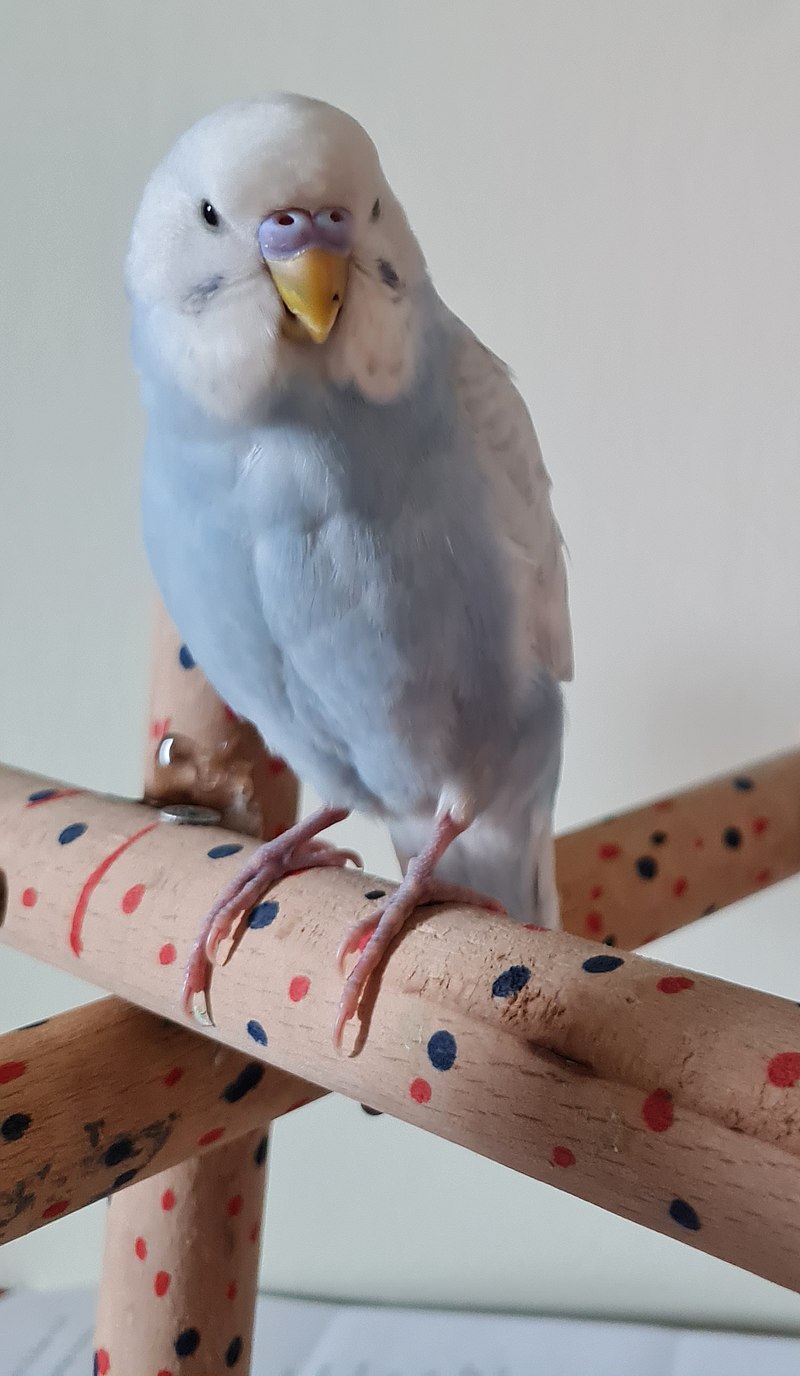
The Budgerigar is a small and beautiful parrot, commonly known as the common parakeet or shell parakeet. It has an average length of 18 cm with a long tail and primarily green-yellow coloration along its body.
Black stripes can be found on their wings and cheeks while they have white rings around their eyes giving them a unique look.
These birds are mainly seed eaters but also love fruits, vegetables, nuts and other grains in captivity.
They are highly social creatures that live in large flocks in the wild but enjoy companionship when kept as pets too.
Their ability to mimic human speech makes them great conversation partners for those living alone who need some company.Scientific classification:
| Kingdom | Animalia |
| Phylum | Chordata |
| Class | Aves |
| Order | Psittaciformes |
| Family | Psittaculidae |
| Subfamily | Loriinae |
| Tribe | Melopsittacini |
| Genus | Melopsittacus Gould, 1840 |
| Species | M. undulatus |
4. Rose-Ringed Parakeet
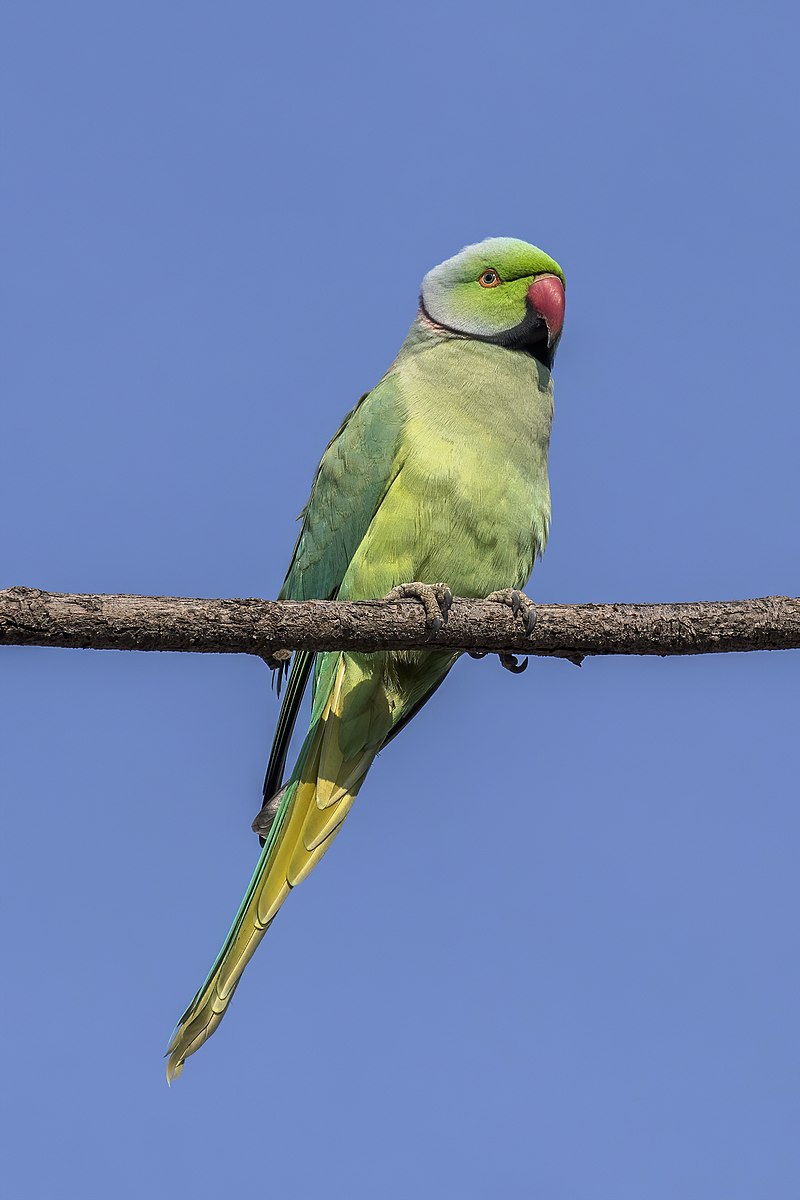
The Rose-ringed parakeet is a medium sized bird in the family Psittacidae. Native to Africa and India, it has been introduced into many other parts of the world where feral populations have now established themselves.
The most distinctive feature of this species is its colorful neck ring ranging from pink to purple which gives them their name.
However, males often display more vibrant colors than females do. This beautiful bird can also imitate human speech quite well making them popular pets worldwide.
In addition they are very social creatures preferring large flocks when out in nature or as part of aviaries during captivity. With proper care these birds can live up to 30 years.Scientific classification:
| Kingdom | Animalia |
| Phylum | Chordata |
| Class | Aves |
| Order | Psittaciformes |
| Family | Psittaculidae |
| Genus | Psittacula |
| Species | P. krameri |
5. Violet-Green Swallow
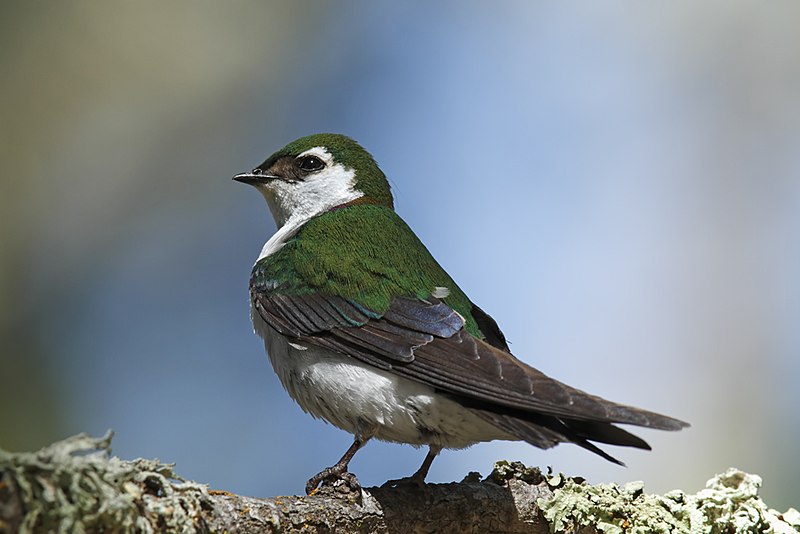
The Violet-green Swallow is a small, North American passerine bird belonging to the swallow family.
These birds are known for their aerial insectivorous diet and beautiful green coloration with white rump side patches that appear as if they’re separating it from other swallows.
They inhabit areas along the west coast of America, ranging from Alaska all the way down to Mexico and also extending eastwards to Montana and Texas.
This species can be seen swooping through open air in search of food or heard chirping away during its mating season – usually occurring between April till late summer months.
It’s an important part of many ecosystems due to its role in controlling insects populations.Scientific classification:
| Kingdom | Animalia |
| Phylum | Chordata |
| Class | Aves |
| Order | Passeriformes |
| Family | Hirundinidae |
| Genus | Tachycineta |
| Species | T. thalassina |
6. Green Jay
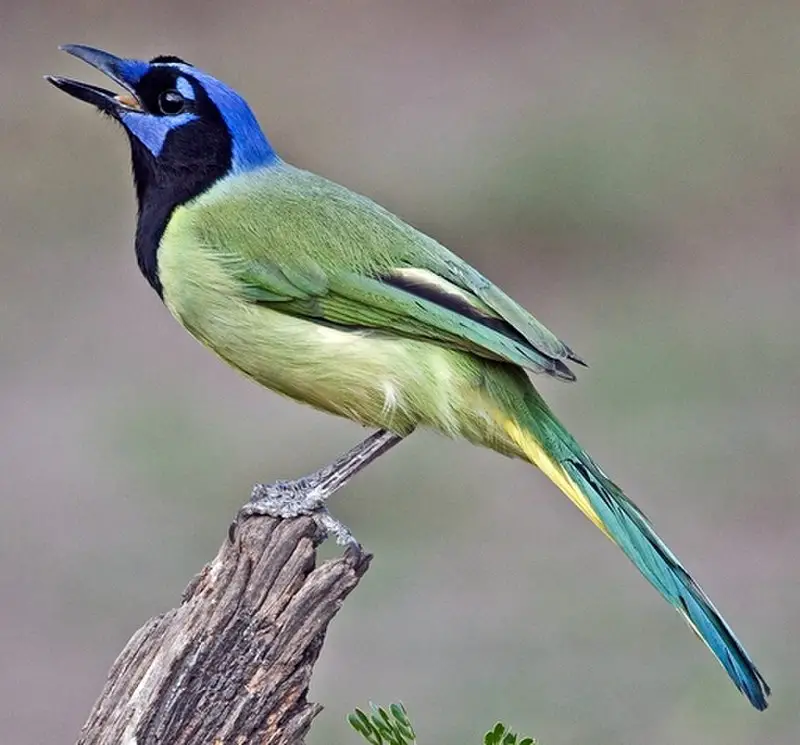
The green jay is a beautiful bird that can be found in Central America. It has blue and black heads, with green wings, mantle and tail. The bill is black while the eye rings are yellow or brown.
Its legs are dark coloured and it measures 27 cm in length. Their diet consists of arthropods, vertebrates, seeds and fruit which provide them with essential nutrients for their survival.
They have adapted to many different habitats like forests, fields and gardens where they live peacefully alongside other birds species until humans interfere with their environment by cutting down trees or polluting water sources amongst others activities that disrupts nature’s balance thus affecting these amazing creatures negatively.Scientific classification:
| Kingdom | Animalia |
| Phylum | Chordata |
| Class | Aves |
| Order | Passeriformes |
| Family | Corvidae |
| Genus | Cyanocorax |
| Species | C. luxuosus |
7. Green Kingfisher
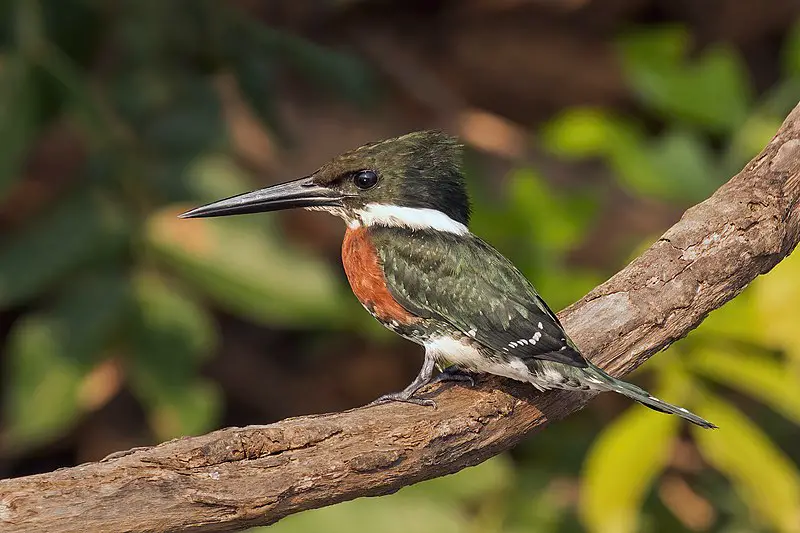
The Green Kingfisher is an incredibly vibrant bird, boasting a bright green plumage and long beak.
It can primarily be found throughout Central America, in most South American countries except Chile, as well as Texas in the United States and Trinidad & Tobago.
This species of water kingfisher belongs to subfamily Cerylinaeof family Alcedinidae which was first described by German naturalist Johann Friedrich Gmeiner back in 1788.
The Green Kingfishers are known for their active hunting habits where they perch above shallow waters looking out for prey such as small fish or crustaceans before diving down rapidly into the water with a loud splash.Scientific classification:
| Kingdom | Animalia |
| Phylum | Chordata |
| Class | Aves |
| Order | Coraciiformes |
| Family | Alcedinidae |
| Subfamily | Cerylinae |
| Genus | Chloroceryle |
| Species | C. americana |
8. Green-Breasted Mango
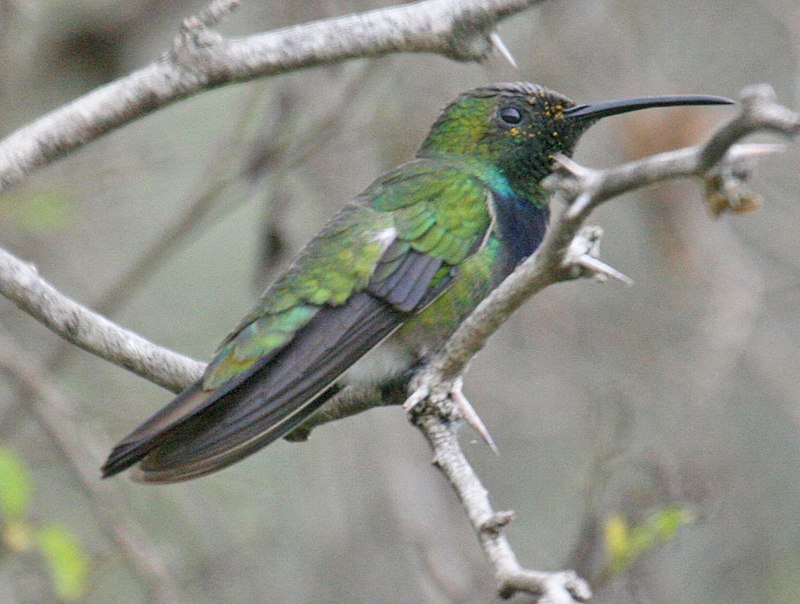
The Green-breasted Mango is a medium-sized hummingbird found in tropical America. The male has an impressive green chest and black bill, while the female’s feathers are more muted with greyish brown tones.
Both sexes have dark central tail feathers but males also feature bright white patches on their flanks.
They measure 11–12 cm long, with males weighing 7.2 g and females 6.8 g – making them slightly smaller than other species of hummingbirds such as the Ruby Throated Hummingbird which can reach up to 16 cm in length.
The scientific name of this fascinating bird commemorates French naturalist Florent Prévost – a fitting homage to its beauty.Scientific classification:
| Kingdom | Animalia |
| Phylum | Chordata |
| Class | Aves |
| Order | Apodiformes |
| Family | Trochilidae |
| Genus | Anthracothorax |
| Species | A. prevostii |
9. Red-Crowned Amazon
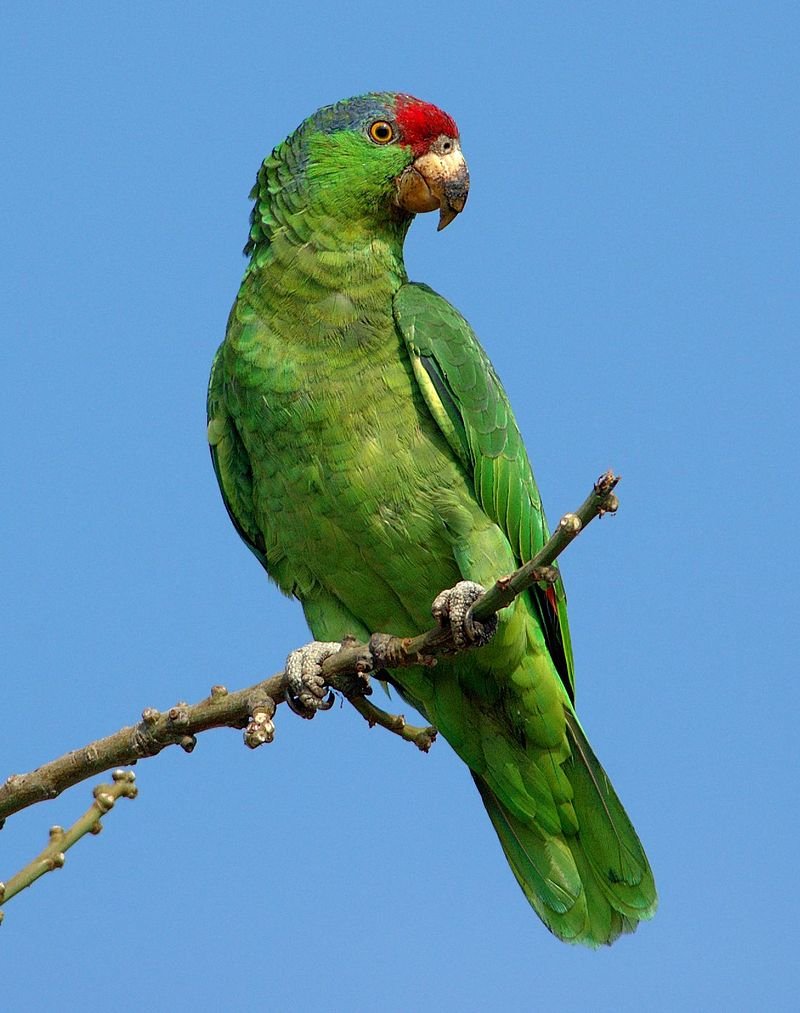
The Red-crowned Amazon is an endangered bird native to northeastern Mexico and possibly southern Texas. This parrot has a distinct red crown, green cheeks, and grayish wings with yellow highlights.
It typically lives in open woodlands near water sources such as rivers or lagoons. The estimated population of the wild stands between 2,000 – 4,300 mature individuals due to habitat destruction and illegal poaching for pet trade purposes.
Conservation efforts are being made by organizations like the IUCN Species Survival Commission Parrots Specialist Group (PSG) which works towards protecting this species from extinction through research projects along its range countries.Scientific classification:
| Kingdom | Animalia |
| Phylum | Chordata |
| Class | Aves |
| Order | Psittaciformes |
| Family | Psittacidae |
| Genus | Amazona |
| Species | A. viridigenalis |
10. Green Rosella
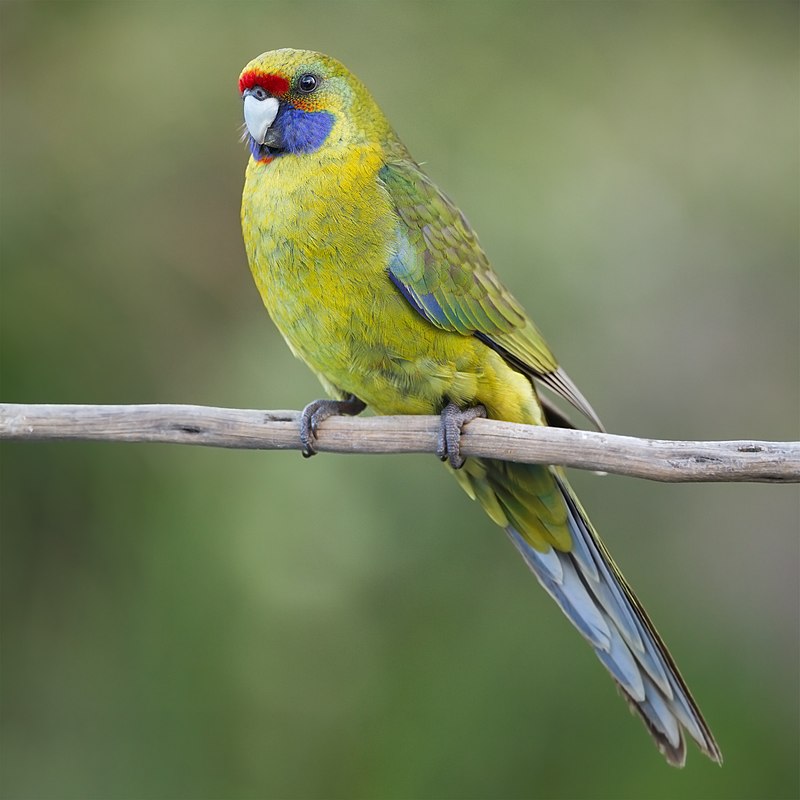
The Green Rosella is a beautiful parrot species that can be found in Tasmania and the Bass Strait islands.
It was first described by German naturalist Johann Friedrich Gmelin in 1788, although it got its name from mistakenly believing it came from New Caledonia.
At 14.5 inches (37 cm) long, this bird is the largest of the rosella genus Platycercus family. Two subspecies are recognised: P.c caledonicus which has bright red underparts and head; and P cecilae with lighter yellowish-orange plumage on its underside.
The upper parts of both male and female birds are green with blue cheeks, black scalloped markings along their wings and tails, while juveniles have brown heads instead of red or orange ones like adults do.
This stunning bird feeds mainly on seeds but also eats fruit, nectar blossoms as well as insects when available.
They typically nest high up in trees where they lay two to three eggs per clutch before incubating them for about 3 weeks until hatching occurs.Scientific classification:
| Kingdom | Animalia |
| Phylum | Chordata |
| Class | Aves |
| Order | Psittaciformes |
| Family | Psittaculidae |
| Genus | Platycercus |
| Species | P. caledonicus |
11. Green Heron
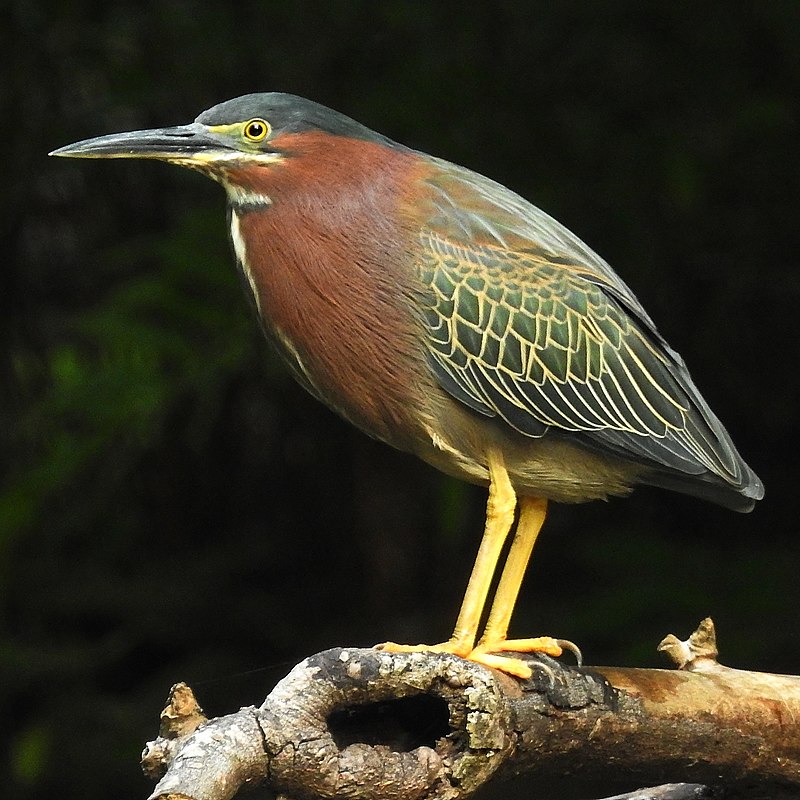
The Green Heron (Butorides virescens) is a small heron found throughout North and Central America.
It’s scientific name comes from Middle English ‘butor’ meaning bittern, combined with the Latin term for its distinctive greenish color – ‘virescens’.
For many years it was considered to be part of the same species as the Striated Heron (Butorides striata), commonly referred to as “green-backed herons”.
The nominate subspecies inhabits wetlands across much of this range, where they can be spotted stalking about in shallow water looking for fish or frogs on which to feed.
They are fascinating wading birds that have even been known to use tools such as sticks or baited lines when fishing.Scientific classification:
| Kingdom | Animalia |
| Phylum | Chordata |
| Class | Aves |
| Order | Pelecaniformes |
| Family | Ardeidae |
| Genus | Butorides |
| Species | B. virescens |
12. Passerine
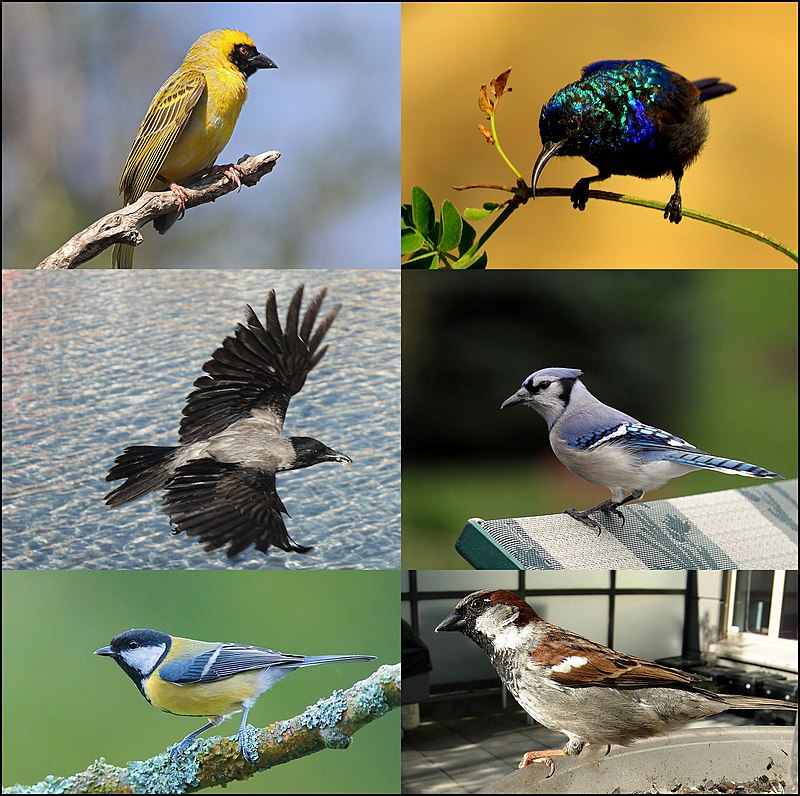
Passerines are a vast order of birds, comprising more than half the species in existence. Many familiar garden and woodland species fall into this category such as sparrows, blackbirds, finches and warblers.
They can be recognised by their arrangement of toes; three pointing forward with one back which helps them perch on branches or wires.
Passerines range from tiny wrens to large crows and have adapted to inhabit many environments around the world including forests, mountainsides and deserts.
They feed mainly on insects but some also consume fruit and seeds depending on their diet preferences.
Their diversity is truly remarkable from vibrant coloured tropical parrots to drab winter thrushes – making passerine birds an integral part of our natural heritage.Scientific classification:
| Kingdom | Animalia |
| Phylum | Chordata |
| Class | Aves |
| Clade | Psittacopasserae |
| Order | Passeriformes Linnaeus, 1758 |
13. Inca Jay
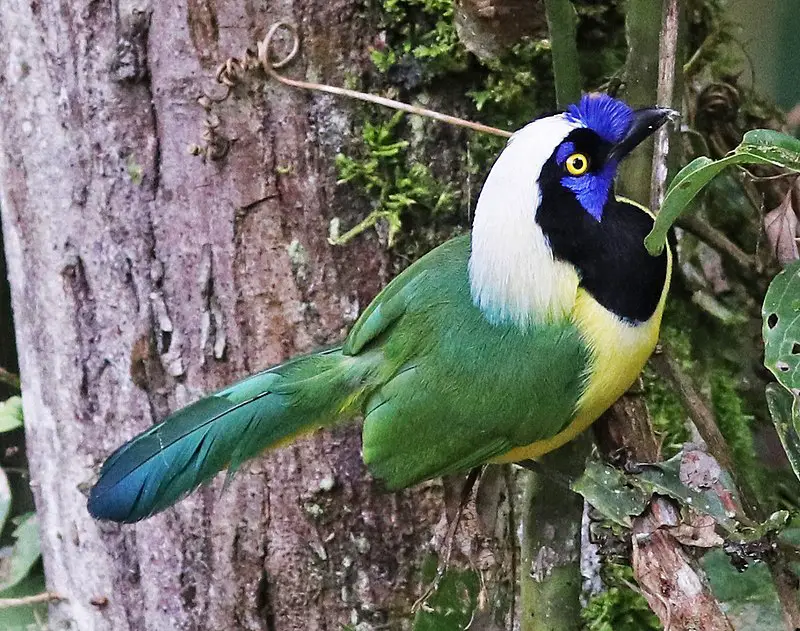
The Inca Jay is a stunning bird native to the Andes Mountains region of South America.
It was first described by French polymath Georges-Louis Leclerc, Comte de Buffon in 1775 and Francois-Nicolas Martinet even illustrated it for his Planches Enluminées D’Histoire Naturelle des Oiseaux.
This species has an unmistakable black crown with white stripes running down its forehead as well as dark blue wings and tail feathers that contrast against its chestnut brown body.
The Inca Jay also features white spotting around the eyes, giving them a unique appearance among other jays in their family.
They are known to be quite vocal birds who like to live amongst trees where they can feed on insects, fruits, seeds and nuts – all while keeping an eye out for potential predators. A truly remarkable species indeed.Scientific classification:
| Kingdom | Animalia |
| Phylum | Chordata |
| Class | Aves |
| Order | Passeriformes |
| Family | Corvidae |
| Genus | Cyanocorax |
| Species | C. yncas |
Also Featured In: Green Birds in That Live in Texas,
14. Hummingbirds
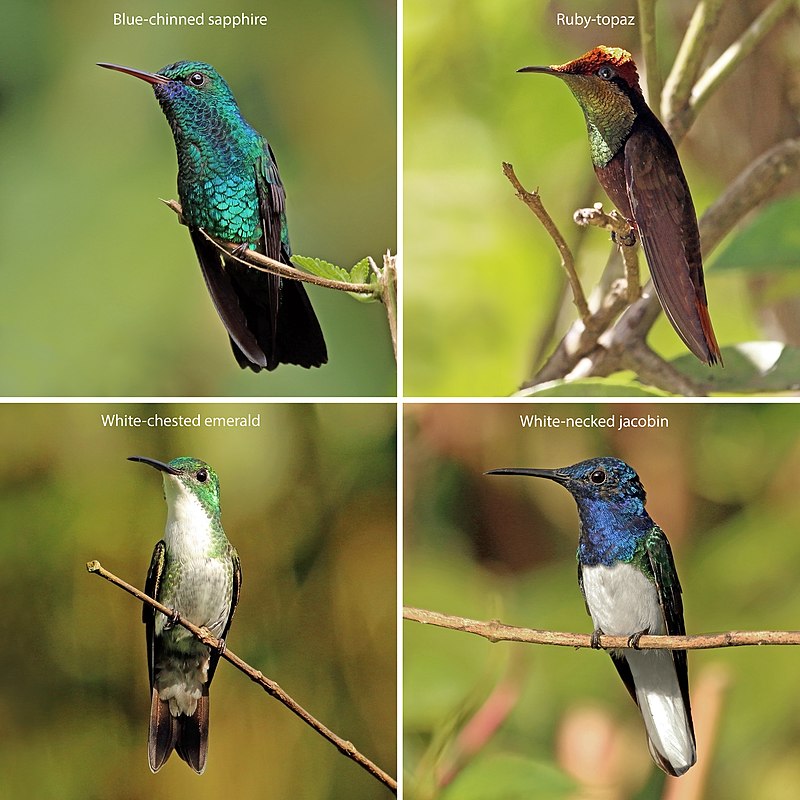
Hummingbirds are tiny birds found throughout the Americas, from Alaska to Tierra del Fuego. Most species measure between 3-5 inches in length and weigh less than an ounce.
The smallest hummingbird is only 2 inches long. Hummingbirds have a unique ability of hovering by rapidly flapping their wings up to 80 times per second.
They feed on nectar and insects, with some species even able to drink sap or eat pollen directly off flowers.
Their vibrant colors make them instantly recognizable as they dart through gardens in search of food and mates.
Hummingbirds truly bring joy into our lives as they remind us that nature’s beauty can be seen around every corner if we take the time to look for it.Scientific classification:
| Kingdom | Animalia |
| Phylum | Chordata |
| Class | Aves |
| Order | Apodiformes |
| Family | Trochilidae Vigors, 1825 |
15. Rosy-Faced Lovebird
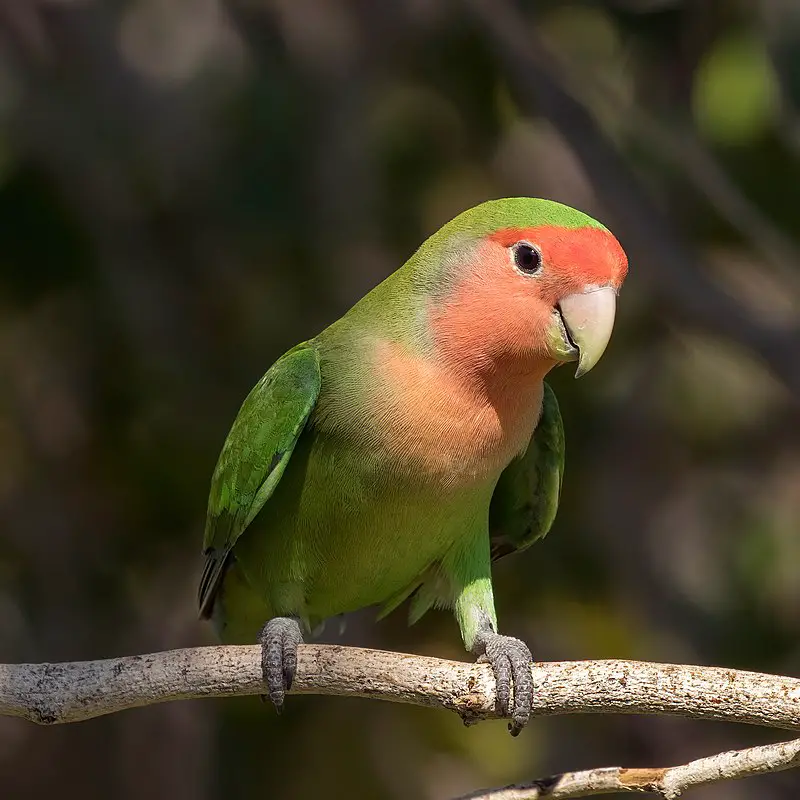
The Rosy-faced Lovebird is a vibrant and social species of bird native to arid regions in southwestern Africa. These small birds are known for their loud chirps which often come as part of large groups in the wild.
They also have wide variation between individuals when it comes to coloration, with some having more rosy hues on their faces than others.
Rosy-faced lovebirds eat throughout the day and enjoy frequent baths – they get most active during sunset where they fly around looking for food or interacting with other members of its flock.
It’s not uncommon to see these little birds playing games amongst themselves.
In captivity, they make wonderful pets due to their intelligence, friendliness and need for companionship from humans or other animals alike; making them great fits into any home environmentScientific classification:
| Kingdom | Animalia |
| Phylum | Chordata |
| Class | Aves |
| Order | Psittaciformes |
| Family | Psittaculidae |
| Genus | Agapornis |
| Species | A. roseicollis |
Also Featured In: Birds that Live in the Deserts, Case Birds that Live in with Us
16. Amazon Parrot
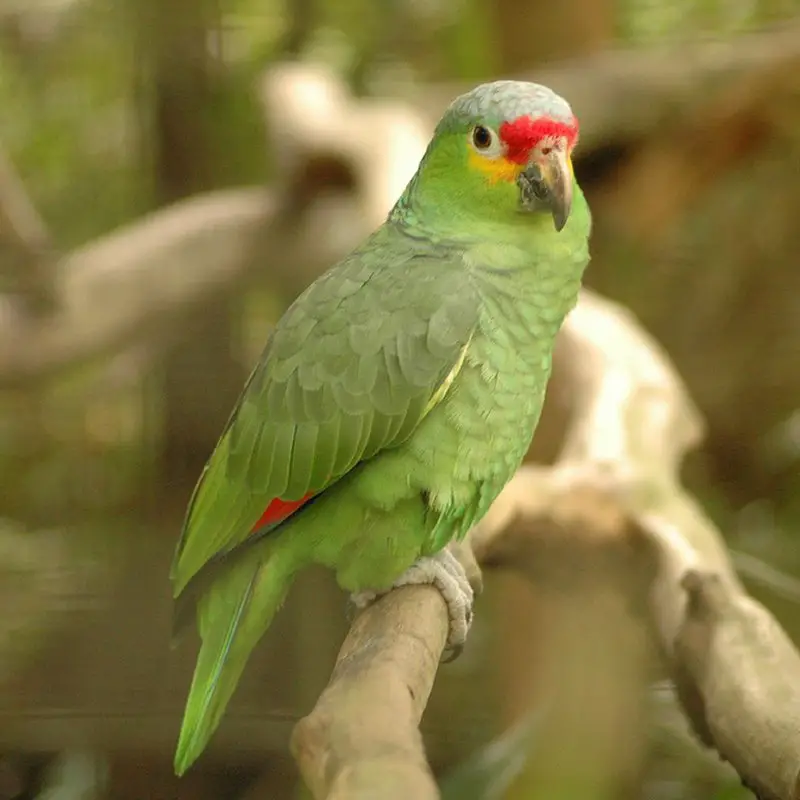
Amazon Parrots are medium-sized, short-tailed parrots native to the Americas. They belong to the genus Amazona and family Psittacidae which comprises of 92 genera and three families of true parrots.
Amazon breed is known for its vibrant colors from blues, greens to yellows that make them an eye-catching beauty in addition to their playful personalities.
These birds have a long lifespan with some living up to 80 years or more making them great companions if well taken care off.
They also possess talking abilities although this does vary between species as some will mimic human speech better than others do.
With proper training they can learn different tricks such as doing somersaults etc., providing hours of entertainment.Scientific classification:
| Kingdom | Animalia |
| Phylum | Chordata |
| Class | Aves |
| Order | Psittaciformes |
| Family | Psittacidae |
| Tribe | Androglossini |
| Genus | Amazona Lesson, 1830 |
Also Featured In: Most Common Birds of Ko Samui,
17. Lovebirds
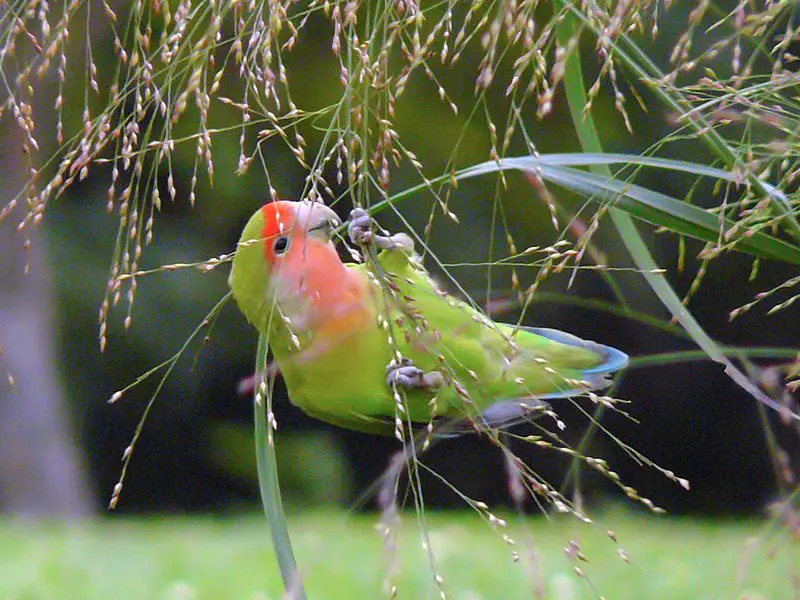
Lovebirds are small, affectionate parrots native to Africa. They form strong bonds with their partner and mate for life, hence the name.
The nine species of lovebird range in size from 12-17 cm long, with most having a bright green plumage and some sporting unique markings on their heads or faces like yellow cheek patches or grey heads.
Lovebirds are social birds that enjoy interacting with each other and human companionship as well. They can be quite vocal too – making chirps, whistles and even screeches when they get excited.
These colourful little birds make wonderful pets if given enough space to roam around safely since they need lots of stimulation from playing toys and activities to stay healthy mentally.Scientific classification:
| Kingdom | Animalia |
| Phylum | Chordata |
| Class | Aves |
| Order | Psittaciformes |
| Family | Psittaculidae |
| Subfamily | Agapornithinae |
| Genus | Agapornis Selby, 1836 |
Also Featured In: Aviary Birds You Should Know, Pet Birds that Live in India
18. Mitred Parakeet
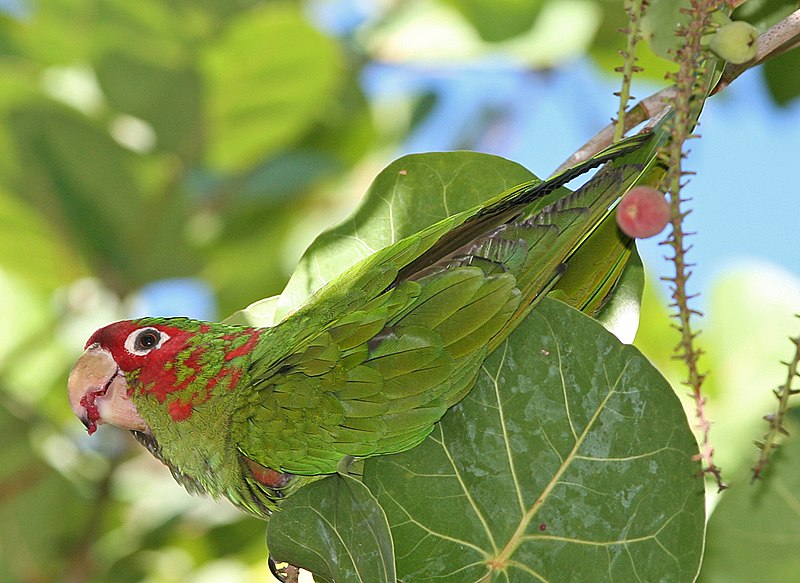
The Mitred Parakeet is a stunning species of parrot with its striking green and red plumage. It is native to the forests and woodlands in South America, ranging from Peru down to Argentina, as well as having introduced populations in California, Florida and Hawaii.
They are gregarious birds that usually inhabit small flocks or pairs while foraging for food on trees or shrubs.
These beautiful birds have unfortunately been declining due to habitat loss caused by deforestation; however they remain relatively common throughout much of their range.
In captivity these intelligent creatures can be easily trained using positive reinforcement techniques such as clicker training which will help them become more comfortable around humans.Scientific classification:
| Kingdom | Animalia |
| Phylum | Chordata |
| Class | Aves |
| Order | Psittaciformes |
| Family | Psittacidae |
| Genus | Psittacara |
| Species | P. mitratus |
Also Featured In: Green Birds Commonly Found in Florida,
19. White-Winged Parakeet
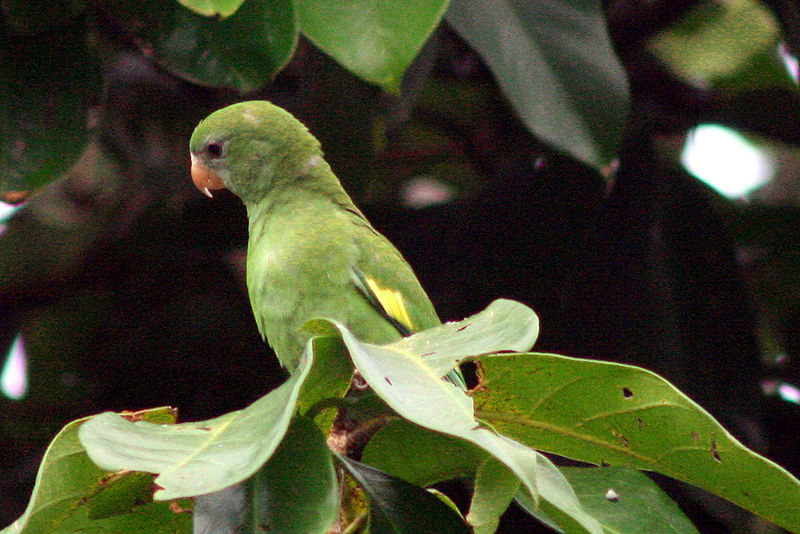
The White-winged parakeet is a beautiful bird native to the Amazon River basin. It has an exotic appearance, with its bright green body and yellow wings trimmed in white.
In addition to being kept as cage birds, they have been released into the wild where self-sustaining populations now exist in Lima, Peru; Los Angeles; Miami, Florida; and Puerto Rico.
These social creatures are known for their playful nature and raucous calls that echo through woodlands or suburban areas as flocks fly overhead.
They also make great pets due to their intelligence and affinity for human interaction – always ready for cuddles.Scientific classification:
| Kingdom | Animalia |
| Phylum | Chordata |
| Class | Aves |
| Order | Psittaciformes |
| Family | Psittacidae |
| Genus | Brotogeris |
| Species | B. versicolurus |
20. Pacific Parrotlet
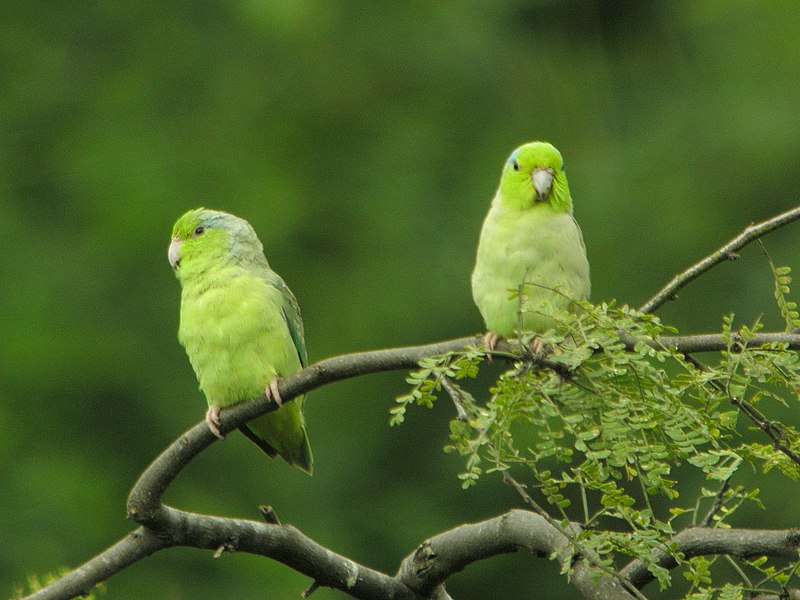
The Pacific parrotlet (Forpus coelestis), also known as Lesson’s parrotlet or the celestial parrotlet, is a species of small green bird from South America.
The average size for this beautiful creature is 11-14 cm in length and it typically weighs 30 grams – or more.
Wild specimens are usually bright green with dust coloured wings, making them quite striking to look at.
They have short stubby tails that add to their charm and they can live up to 15 years when cared for properly.
These friendly birds make excellent pets due to their calm nature and will even learn how to say simple phrases if taught correctly.
In captivity, these Parrotlets thrive best when there is plenty of social interaction with humans and other birds alike.Scientific classification:
| Kingdom | Animalia |
| Phylum | Chordata |
| Class | Aves |
| Order | Psittaciformes |
| Family | Psittacidae |
| Genus | Forpus |
| Species | F. coelestis |
21. Red-Eyed Vireo
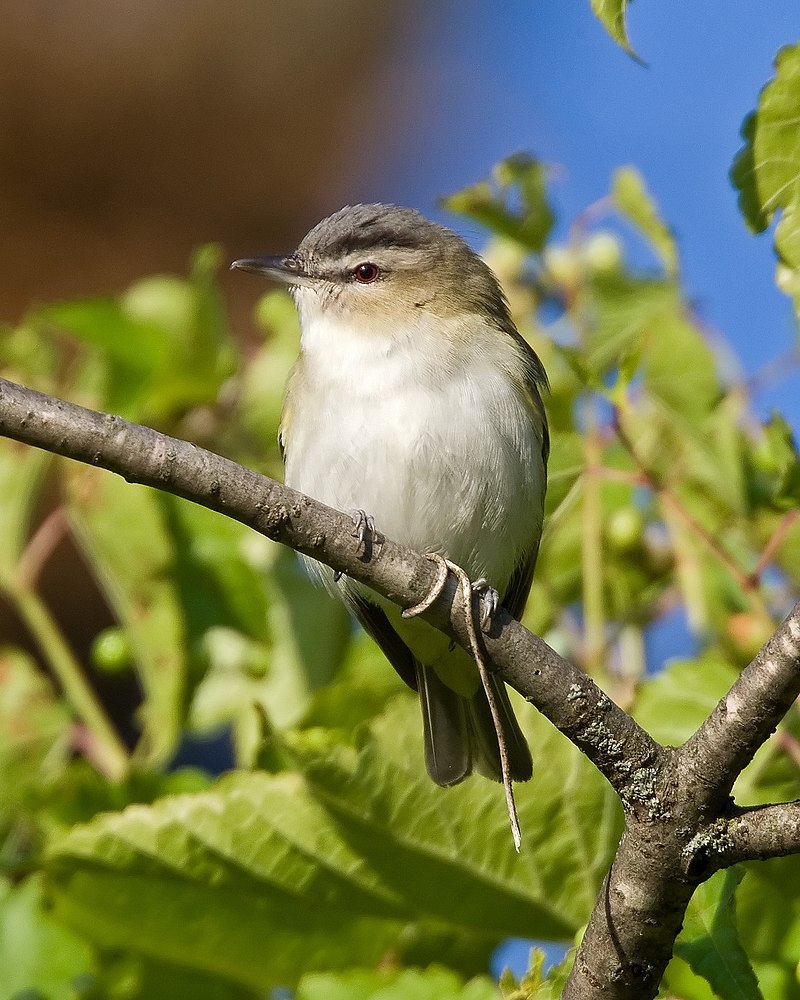
The Red-eyed Vireo is a small American songbird that resembles warblers, but its not closely related to them.
It has a vast range across North America and is considered fairly common throughout the region, with no notable threats resulting in it being classified as Least Concern on the IUCN’s red list.
Its name derives from Latin words meaning “green migratory bird”, most likely referring to female golden orioles or European greenfinches.
The species of vireos have striking plumage including bright yellow bellies and white stripes above their eyes which are surrounded by an orangey-red coloration – hence their namesake.Scientific classification:
| Kingdom | Animalia |
| Phylum | Chordata |
| Class | Aves |
| Order | Passeriformes |
| Family | Vireonidae |
| Genus | Vireo |
| Species | V. olivaceus |
22. Carolina Parakeet
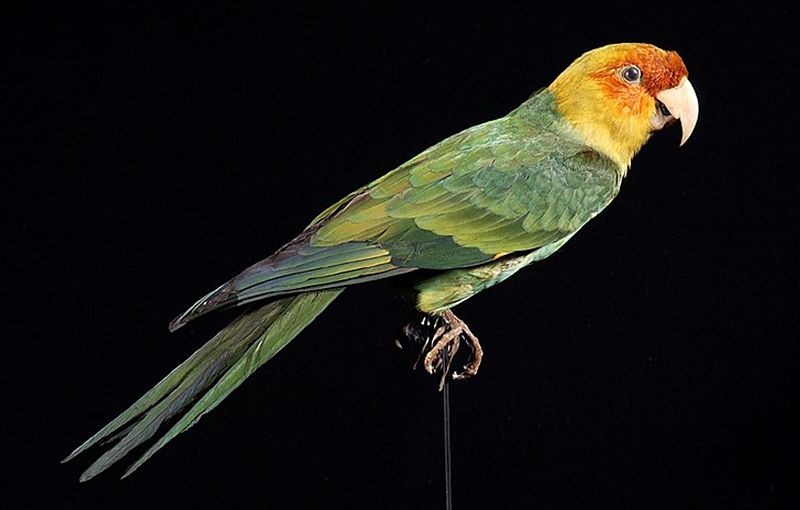
The Carolina parakeet was a small green neotropical parrot with a bright yellow head, reddish orange face and pale beak. It was the only species of its kind found in the eastern, Midwest and plains states of the US.
This native bird had been around since before Europeans first arrived in America but unfortunately it has become extinct due to human activities such as deforestation and hunting for their feathers.
Despite being so brightly colored they were notoriously hard to spot because they flew quickly through dense forests making them difficult targets for hunters who wanted their colorful plumage.
Sadly this unique American bird is now gone forever leaving us with just two other native parrot species -the Red-crowned Amazon Parrots and Thick-billed Parrots which both live in Mexico today.Scientific classification:
| Kingdom | Animalia |
| Phylum | Chordata |
| Class | Aves |
| Order | Psittaciformes |
| Family | Psittacidae |
| Tribe | Arini |
| Genus | †Conuropsis Salvadori, 1891 |
| Species | †C. carolinensis |
23. Wilson’s Warbler
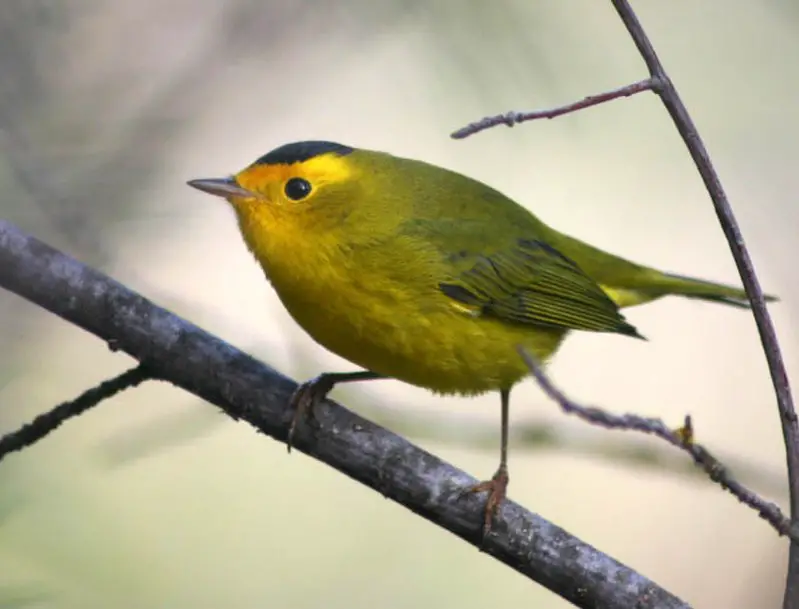
Wilson’s warbler is a small, brightly coloured bird found across North America. It has greenish upperparts and yellow underparts, with rounded wings and a long tail.
The male has an easily identifiable black crown patch which may or may not be present in the female depending on the subspecies.
They breed from Canada down to central parts of Mexico and then winter south through much of Central America.
These birds are usually seen flitting around low vegetation as they search for insects to eat – their main food source.
Their cheerful song can often be heard during spring migration when they travel back up north to breed again after spending winter further south.Scientific classification:
| Kingdom | Animalia |
| Phylum | Chordata |
| Class | Aves |
| Order | Passeriformes |
| Family | Parulidae |
| Genus | Cardellina |
| Species | C. pusilla |
24. Turaco
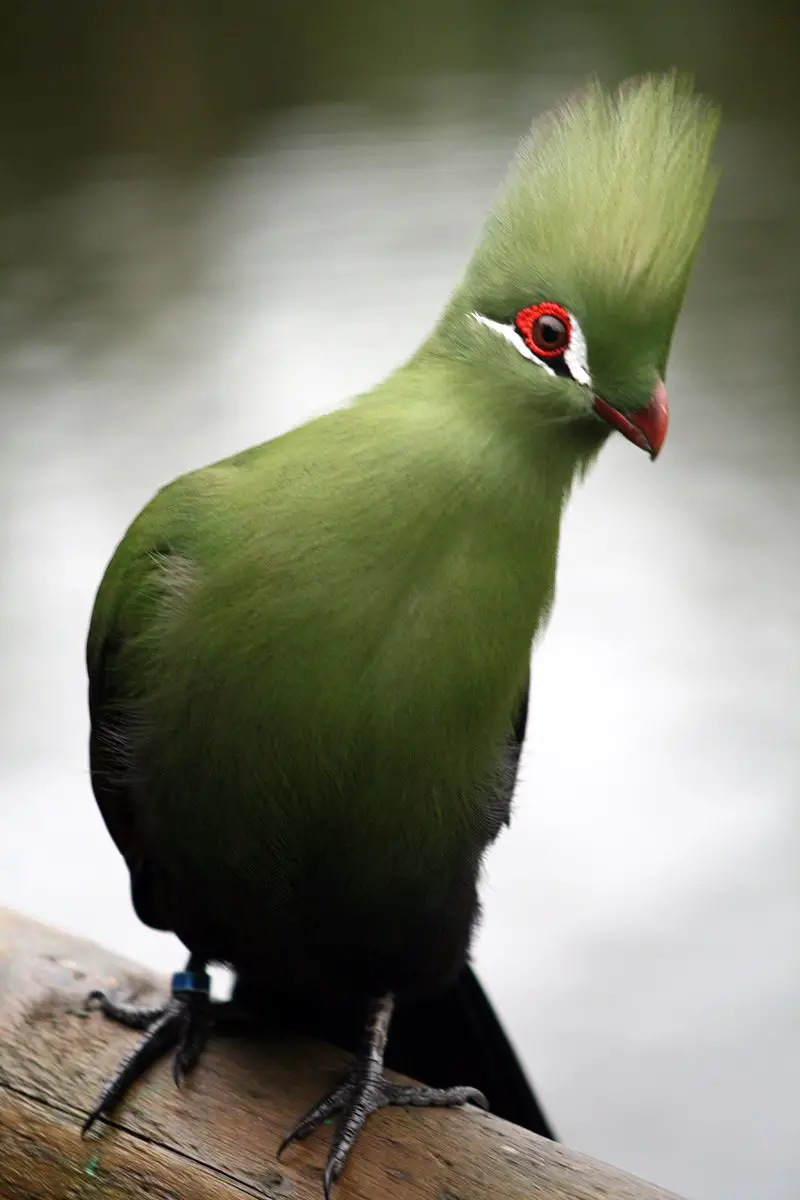
Turacos are a unique bird family that inhabit tropical and subtropical regions of Africa. They are also known as “banana-eaters” or “loeries” in southern Africa, due to their diet which consists mostly of fruit such as plantains.
These birds have an interesting semi-zygodactylous foot structure – the fourth toe can be switched back and forth while the second and third toes remain conjoined.
Turacos come in different sizes depending on species but they all generally boast bright colors like green, blue, purple or red feathers with vibrant yellow eyes.
In addition to being beautiful creatures, these birds make loud calls during mating season which makes them even more special.Scientific classification:
| Kingdom | Animalia |
| Phylum | Chordata |
| Class | Aves |
| Clade | Otidimorphae |
| Order | Musophagiformes Seebohm, 1890 |
| Family | Musophagidae Lesson, 1828 |
25. Orange-Crowned Warbler
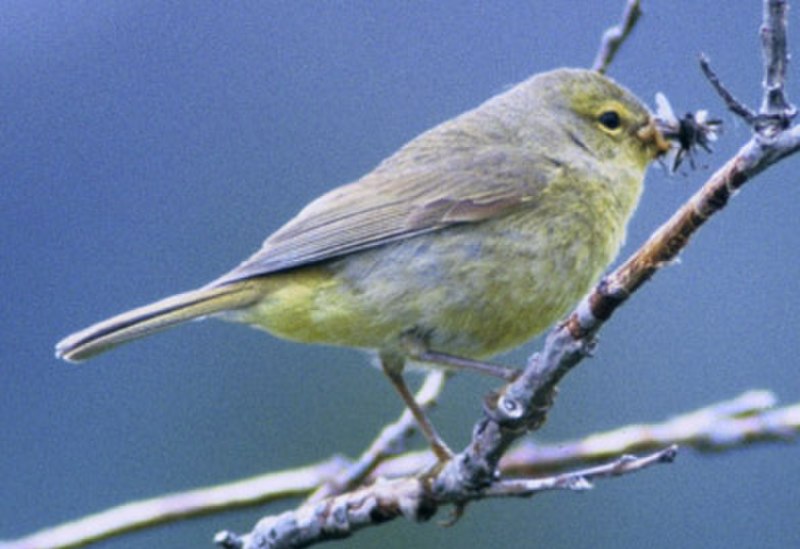
The Orange-crowned Warbler is a small songbird from the New World warbler family. It was formally described in 1822 by Thomas Say, who gave it its scientific name Sylvia celatus – Latin for ‘cloaked’.
This species has an olive green back and wings with yellowish underparts. The males have bright orange crowns during breeding season, which give this bird its namesake.
They can be found mainly in North America but they also migrate to Central America during winter months.
Their diet consists of insects such as butterflies, moths, grasshoppers and beetles; they may also consume fruits occasionally when available.
These birds are relatively quiet except for their mating calls which include whistles or buzzing sounds that last a few seconds long each time.
The Orange-crowned Warbler is one of the most wide spread passerines today due to their hardiness and adaptability; however there remains threat of habitat destruction that could affect many populations negatively if not addressed soon enough.Scientific classification:
| Kingdom | Animalia |
| Phylum | Chordata |
| Class | Aves |
| Order | Passeriformes |
| Family | Parulidae |
| Genus | Leiothlypis |
| Species | L. celata |
26. Eurylaimidae
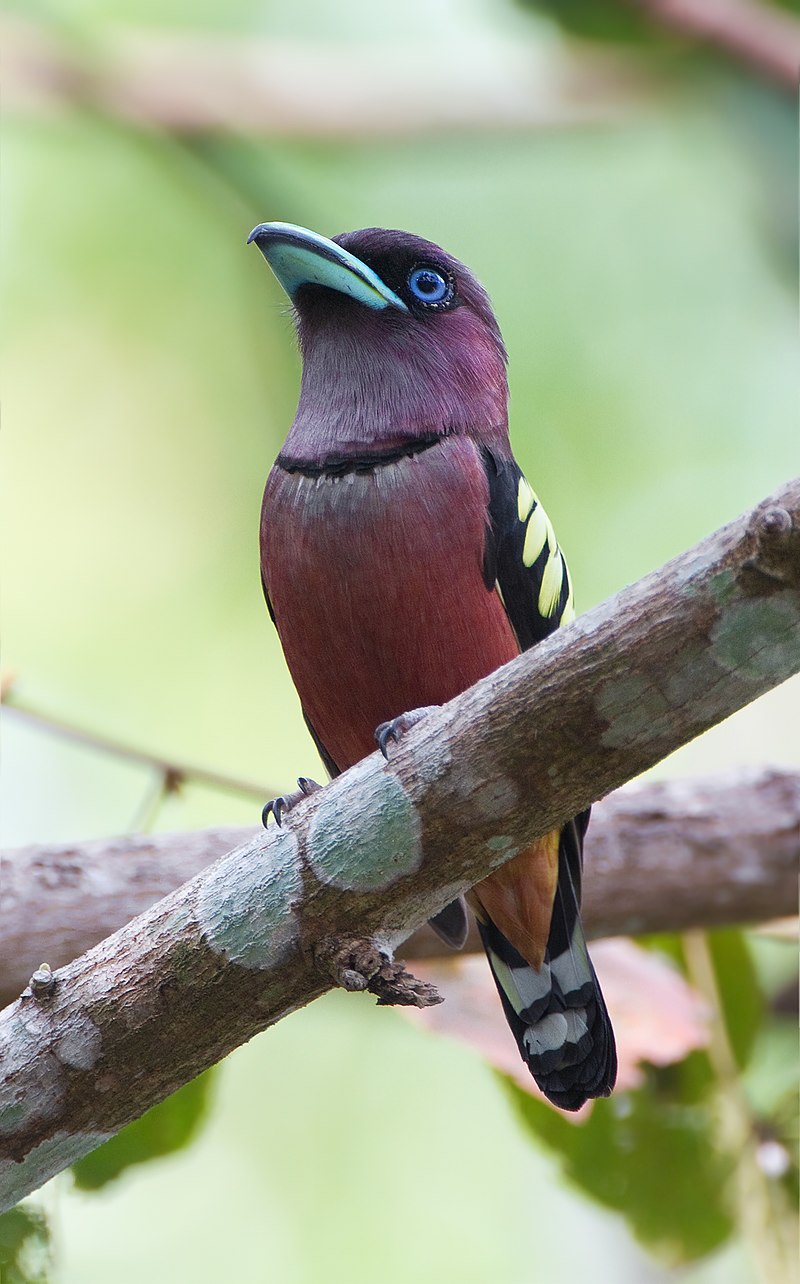
The Eurylaimidae family of birds is a diverse group, found in the eastern Himalayas all the way to Indonesia and Philippines.
They are suboscine passerines that have been known for their bright colours and broad heads.
Majority of these species live in tropical forests or wetlands, where they feed on small invertebrates like insects and worms.
Some specific species such as drongos use mimicry calls to communicate with other animals while most eurylaimids sing beautiful songs during mating season or territorial disputes.
In addition, many members of this family can actively hunt prey using aerial manoeuvres which make them interesting study subjects for ornithologists around the world.Scientific classification:
| Kingdom | Animalia |
| Phylum | Chordata |
| Class | Aves |
| Order | Passeriformes |
| Superfamily | Eurylaimoidea |
| Family | Eurylaimidae Lesson, 1831 |
27. Yellow-Chevroned Parakeet
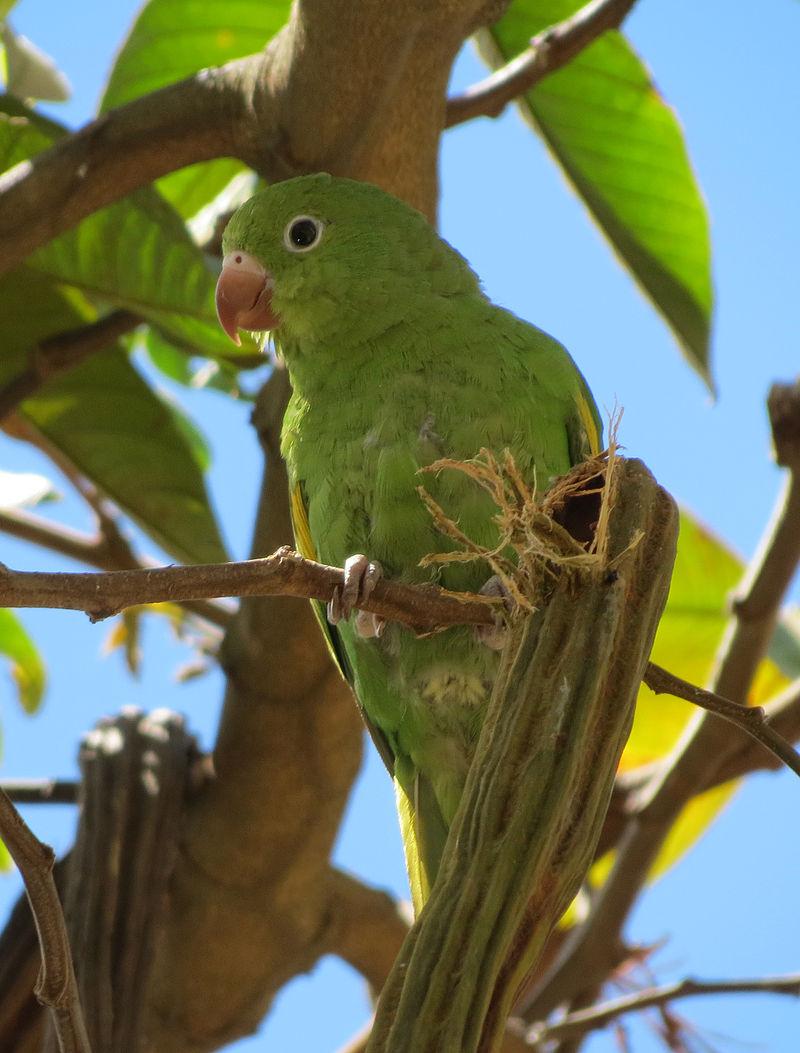
The Yellow-chevroned parakeet is a striking bird native to tropical South America, from central Brazil all the way down to northern Argentina. It has bright yellow and green plumage with distinctive chevrons around its neck and wings.
The Yellow-chevroned parakeet can be found in a variety of habitats including rain forest edges, palm groves, and grasslands.
Unfortunately, many have been released as pets into new areas where they are not naturally occurring such as Florida or California – but some of these populations have successfully established themselves.
This small yet resilient species is sure to capture your heart while out on an adventure exploring the wilds of South America.Scientific classification:
| Kingdom | Animalia |
| Phylum | Chordata |
| Class | Aves |
| Order | Psittaciformes |
| Family | Psittacidae |
| Genus | Brotogeris |
| Species | B. chiriri |
28. European Greenfinch
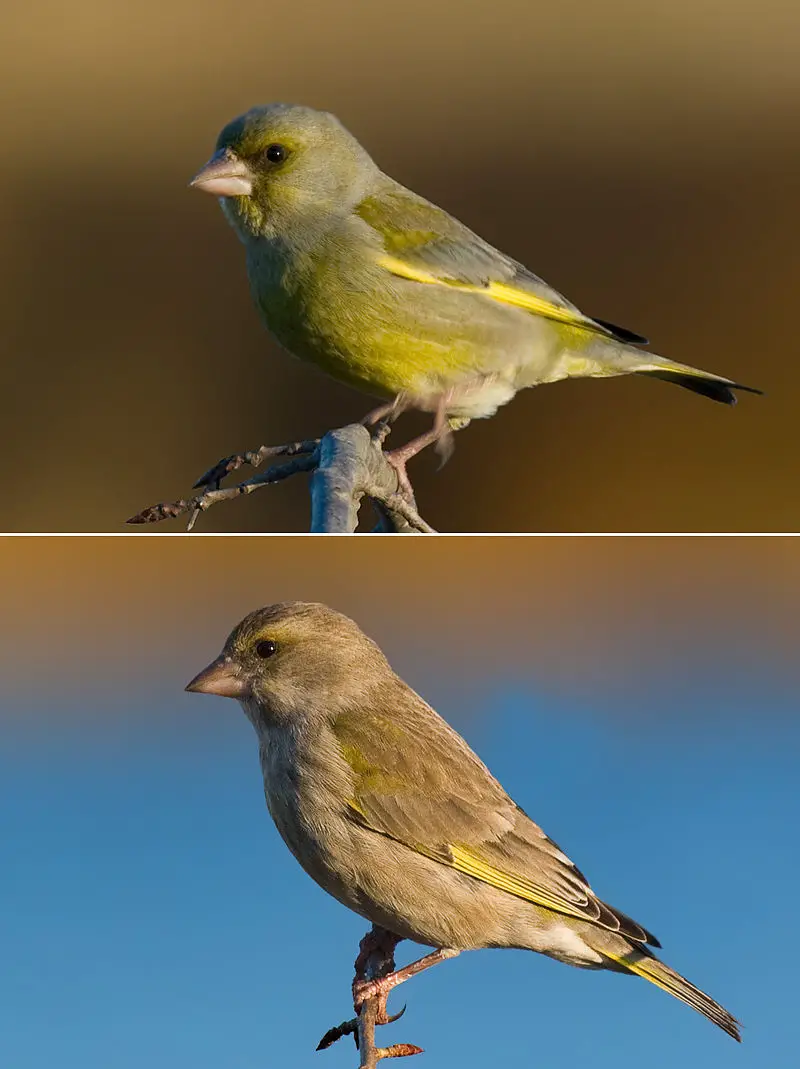
The European Greenfinch is a small, passerine bird from the finch family Fringillidae. It can be found throughout Europe, North Africa and Southwest Asia.
Some of its northernmost populations migrate further south during winter for warmer climates.
The species has been introduced to Australia, New Zealand, Uruguay and Argentina as well with great success in these new environments.
It was first described scientifically by Carl Linnaeus back in 1758 who noted its bright green feathers along with yellow edges on the wings and tail which make it an unmistakable sight when seen up close or at a distance while flying through open grasslands or wooded areas where they are known to feed on insects and seeds alike making them highly adaptable birds that find food sources easily wherever they go.Scientific classification:
| Kingdom | Animalia |
| Phylum | Chordata |
| Class | Aves |
| Order | Passeriformes |
| Family | Fringillidae |
| Subfamily | Carduelinae |
| Genus | Chloris |
| Species | C. chloris |
29. Tanagers
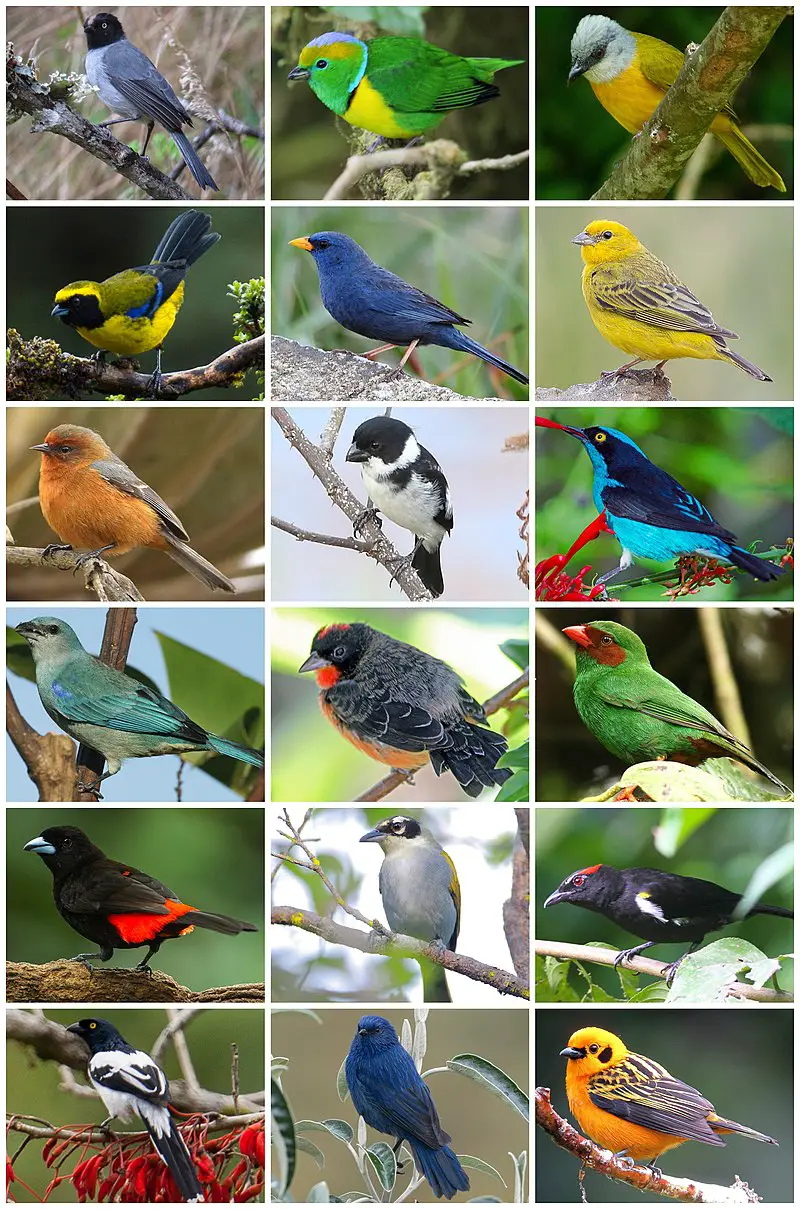
The Tanagers are a beautiful and diverse family of birds native to the Neotropical region. They boast an impressive array of colors, including blues, greens, yellows and reds.
The most common type is the fruit-eating tanager that can be found in tropical forests across Latin America. With nearly 240 species worldwide, they represent almost 4% of all avian species.
These vibrant birds have adapted well to their environment due to their strong bills used for cracking open hard fruits as well as sharp claws for gripping branches while feeding or perching.
As with many other bird families there is natural variation among populations making each one unique in its own way; something that makes them even more special.Scientific classification:
| Kingdom | Animalia |
| Phylum | Chordata |
| Class | Aves |
| Order | Passeriformes |
| Superfamily | Emberizoidea |
| Family | Thraupidae Cabanis, 1847 |
30. Green Honeycreeper
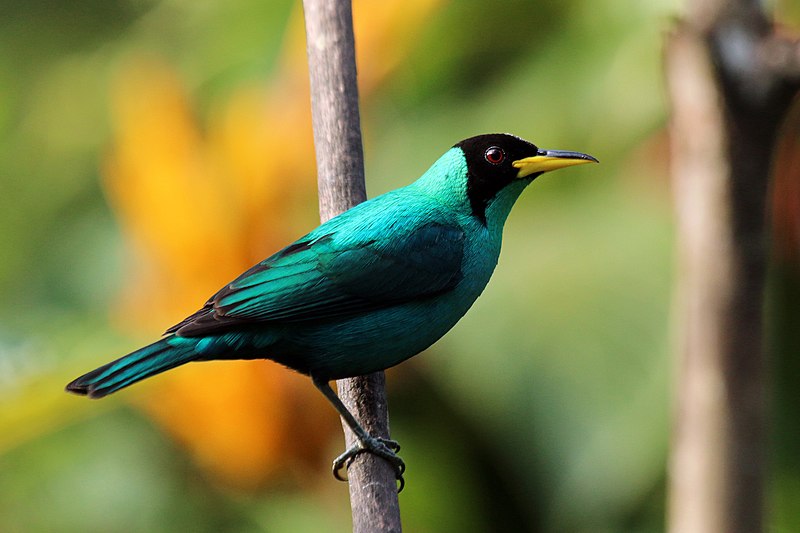
The Green Honeycreeper is a vibrant and colorful bird of the tanager family. It can be found in tropical parts of Mexico, Central America and South America up to Brazil.
This species was first formally described by Swedish naturalist Carl Linnaeus in 1758 under its current name Mota.
The bright green plumage gives it an attractive look making them popular among ornithologists and nature lovers alike.
They mainly feed on nectar from flowers as well as small insects which they catch while flying or hopping around trees and shrubs near forest edges.
These birds are known for their melodious songs often heard during mating season when males sing to attract females – a trait that helps make these birds so captivating.Scientific classification:
| Kingdom | Animalia |
| Phylum | Chordata |
| Class | Aves |
| Order | Passeriformes |
| Family | Thraupidae |
| Genus | Chlorophanes Reichenbach, 1853 |
| Species | C. spiza |
Also Featured In: Rainforest Birds You Should Know, Common Tropical Rainforest Birds
31. Lewis’s Woodpecker
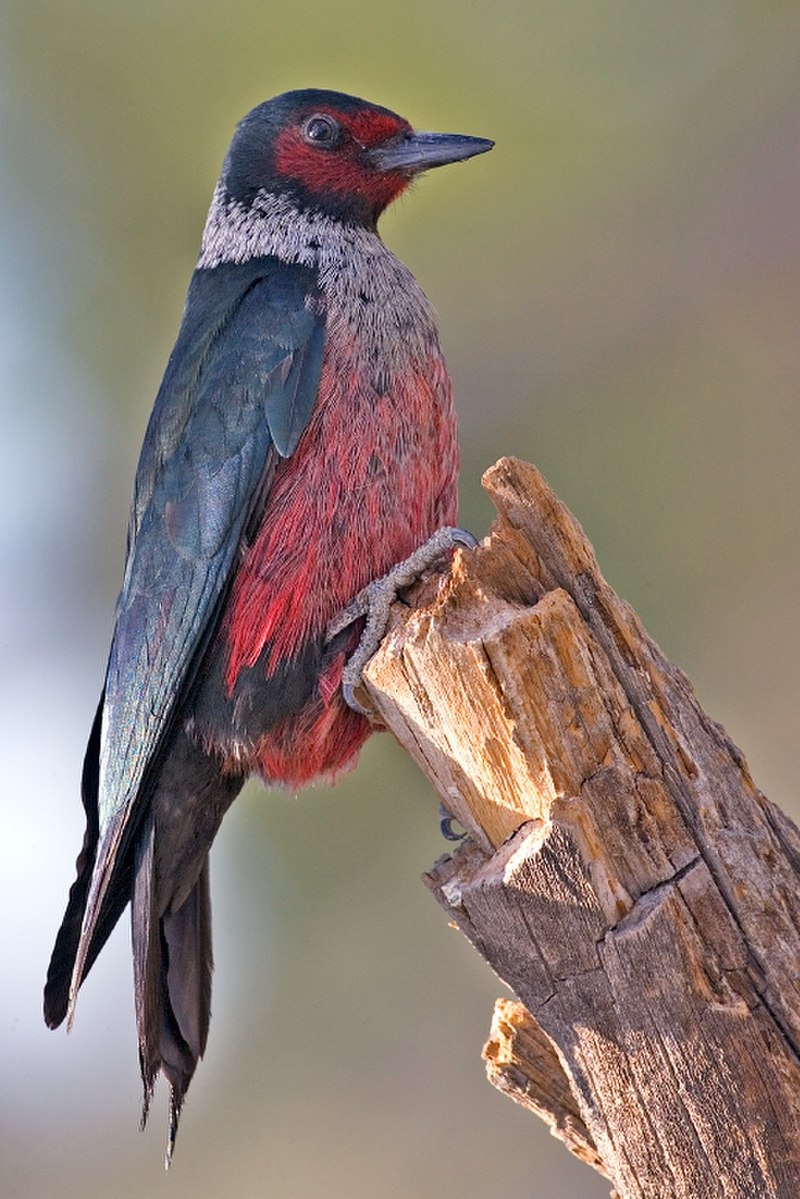
Lewis’s woodpecker is a large species of North American bird, discovered and named after Meriwether Lewis by the ornithologist Alexander Wilson.
Its body measures 18-23 cm in length, with a wingspan ranging from 25 to 30 cm.
It has dark plumage on its back and head that transitions into lighter brown feathers on its chest, belly and tail.
The male bird has bright red patches along the sides of his neck as well as at the base of his bill while females have pinkish or yellow tones instead.
This species primarily feeds on insects such ants which it finds underneath bark or near dead trees where they live their solitary lives except during mating season when pairs form temporary bonds for breeding purposes before going off alone again afterwards.Scientific classification:
| Kingdom | Animalia |
| Phylum | Chordata |
| Class | Aves |
| Order | Piciformes |
| Family | Picidae |
| Genus | Melanerpes |
| Species | M. lewis |
32. Golden-Crowned Kinglet
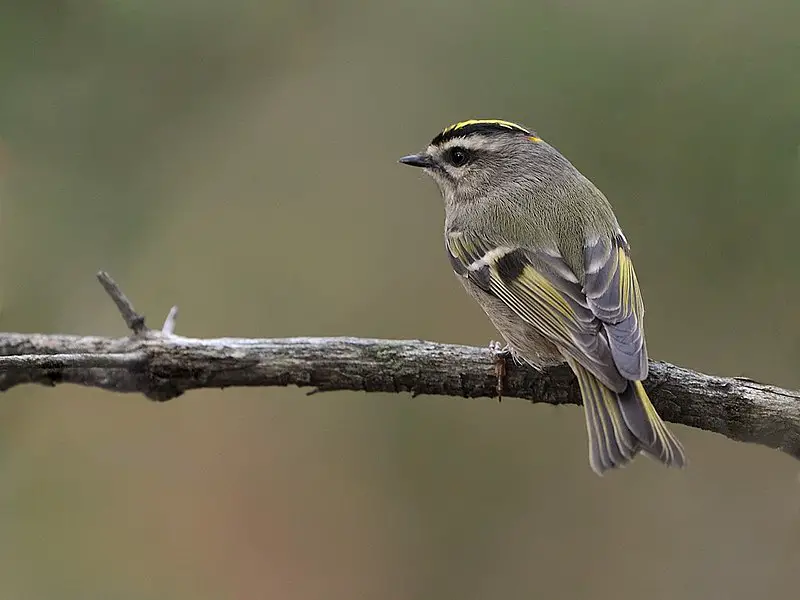
The Golden-crowned Kinglet is a small songbird native to North America. It has an olive-gray top and white underparts, with thin bills and short tails.
The most distinguishing feature of this bird is its yellow crown, surrounded by a black patch that extends through the eyes.
Males have an additional orange patch in the middle of their yellow crowns. They are active birds, often seen flitting from branch to branch as they search for insects or other food sources in trees or shrubs.
During winter months when there’s less insect prey available, Golden-crowned Kinglets will join mixed species flocks searching for berries on bushes and trees throughout forests across North America.Scientific classification:
| Kingdom | Animalia |
| Phylum | Chordata |
| Class | Aves |
| Order | Passeriformes |
| Family | Regulidae |
| Genus | Regulus |
| Species | R. satrapa |
33. Ruby-Crowned Kinglet
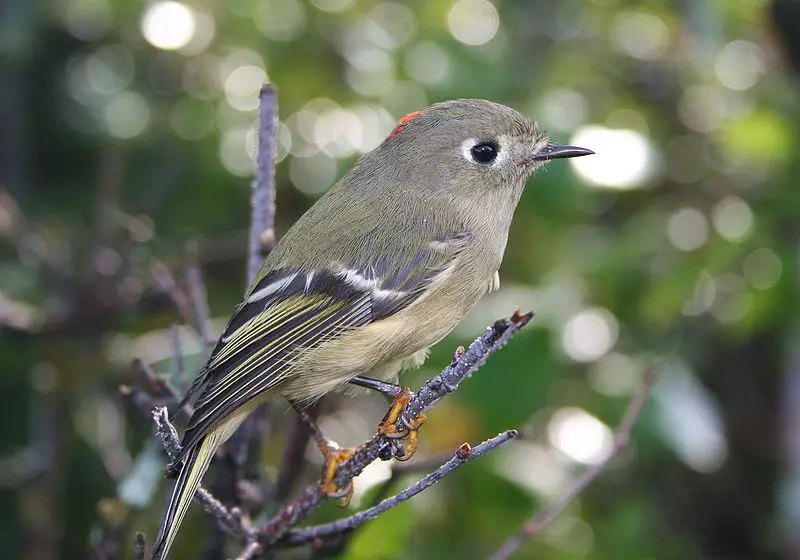
The Ruby-crowned Kinglet is a small passerine bird native to North America. It has olive green plumage, white wing bars and an eye-ring as well as a distinctive red crown patch on the males.
Juveniles look similar to adults with no distinguishing features other than size.
They are usually found in coniferous forests or woodlands where they spend much of their time searching for insects among foliage and branches while constantly flitting from place to place.
These birds have incredible energy levels that allow them to travel long distances during migration season without getting exhausted too quickly, making them one of nature’s most resilient species.Scientific classification:
| Kingdom | Animalia |
| Phylum | Chordata |
| Class | Aves |
| Order | Passeriformes |
| Family | Regulidae |
| Genus | Corthylio Cabanis, 1853 |
| Species | C. calendula |
34. Mallard
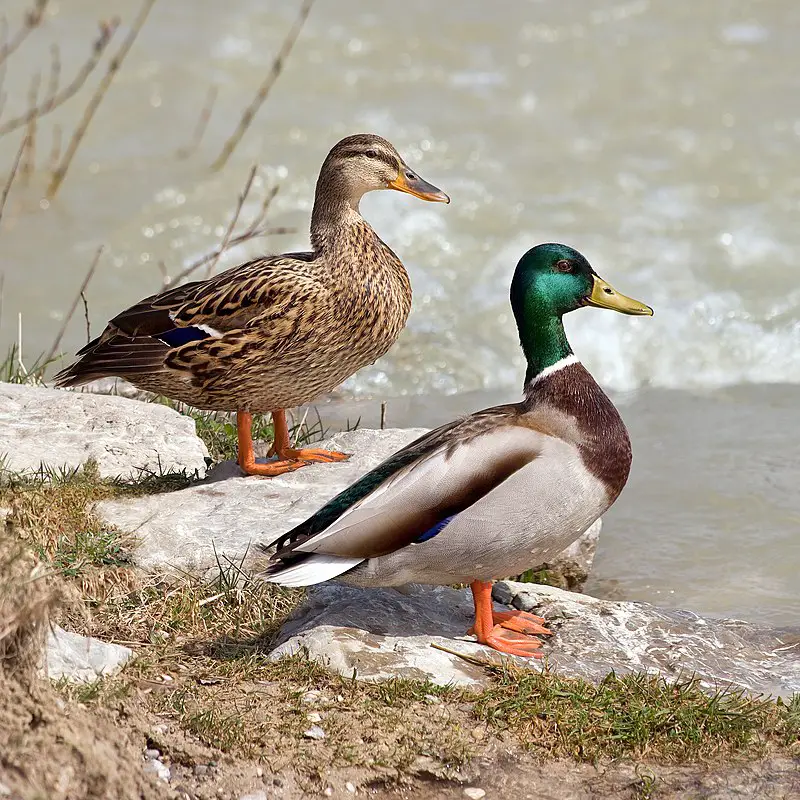
The Mallard is a species of dabbling duck that can be found living in temperate and subtropical regions across the Americas, Eurasia and North Africa.
It has been introduced to other areas such as New Zealand, Australia, Peru, Brazil and South Africa by humans.
This beautiful bird belongs to the Anatinae subfamily of waterfowl family Anatidae. The adult mallards have a glossy green head with white neck ring surrounding.
It along with brownish grey body feathers making them look stunning when they fly away or just sitting in their natural habitat around lakes or ponds.
They are excellent swimmers too due to webbed feet which helps them swim fast underwater while looking for food like aquatic insects etc.. Their loud quacking sound makes them quite popular among nature lovers.Scientific classification:
| Kingdom | Animalia |
| Phylum | Chordata |
| Class | Aves |
| Order | Anseriformes |
| Family | Anatidae |
| Genus | Anas |
| Species | A. platyrhynchos |
35. Mexican Violetear
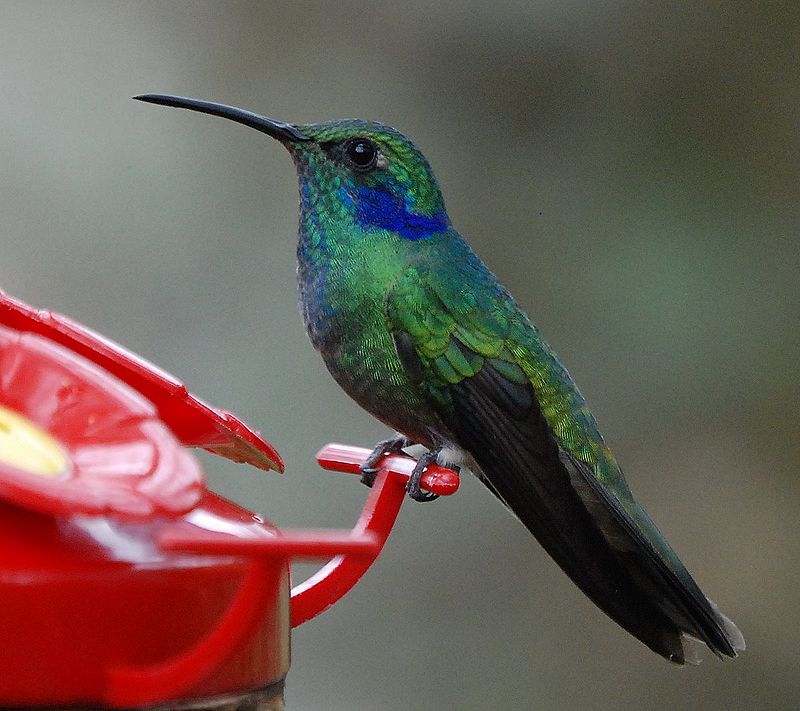
The Mexican Violetear is a gorgeous bird with its metallic green feathers and unique violet ear patch. It belongs to the order Apodiformes, which includes hummingbirds as well as swifts such as the white-throated needletail.
Native to Mexico, Nicaragua and several other Central American countries, it can typically be found in forested areas.
The species was once considered conspecific with another hummingbird called the lesser violetear but has since been identified separately by scientists.
These birds are medium-sized and feed on nectar from flowers that they access using their long curved bills – a trait shared by many members of this family of birds.
They also eat small insects for extra energy during migration or nesting season when food sources may become scarce.Scientific classification:
| Kingdom | Animalia |
| Phylum | Chordata |
| Class | Aves |
| Order | Apodiformes |
| Family | Trochilidae |
| Genus | Colibri |
| Species | C. thalassinus |
36. Asian Green Bee-Eater
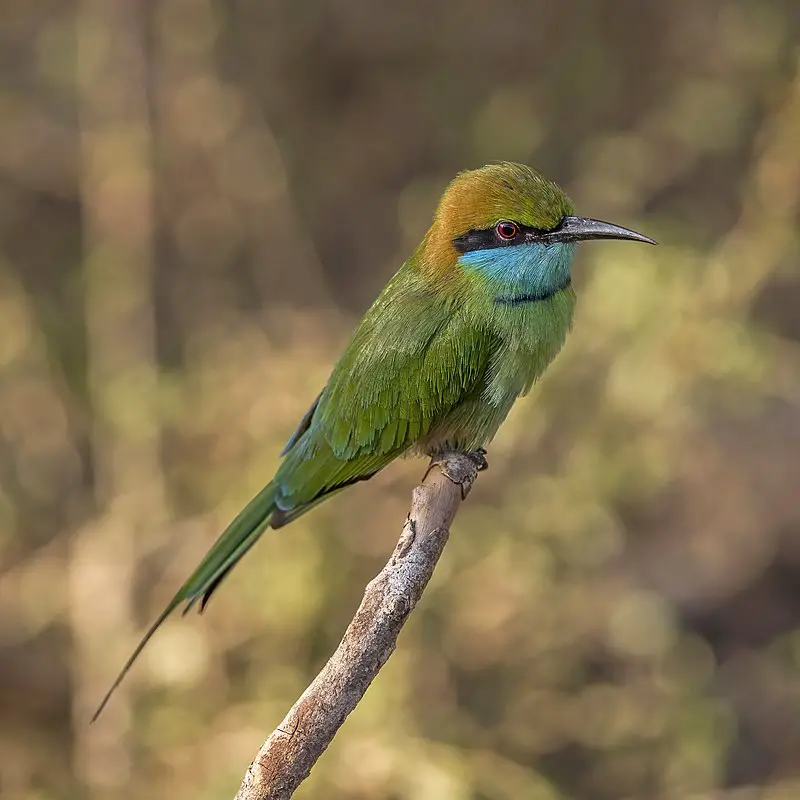
The Asian green bee-eater is a near passerine bird in the bee-eater family. It’s native to parts of Asia, stretching from Iran all the way over to Vietnam.
These birds are resident but tend to migrate seasonally and can also be found in Africa and Arabia.
They have bright green feathers on their upperparts with yellowish underparts, making them easy to spot when they’re flying around looking for insects like bees, wasps and dragonflies.
They usually nest burrows dug into sandy ground or riverbanks where they lay up to five eggs at once.
The Asian green bee-eater is an exciting species that has been popular among ornithologists since its discovery hundreds of years ago.Scientific classification:
| Kingdom | Animalia |
| Phylum | Chordata |
| Class | Aves |
| Order | Coraciiformes |
| Family | Meropidae |
| Genus | Merops |
| Species | M. orientalis |
37. Green-Cheeked Parakeet
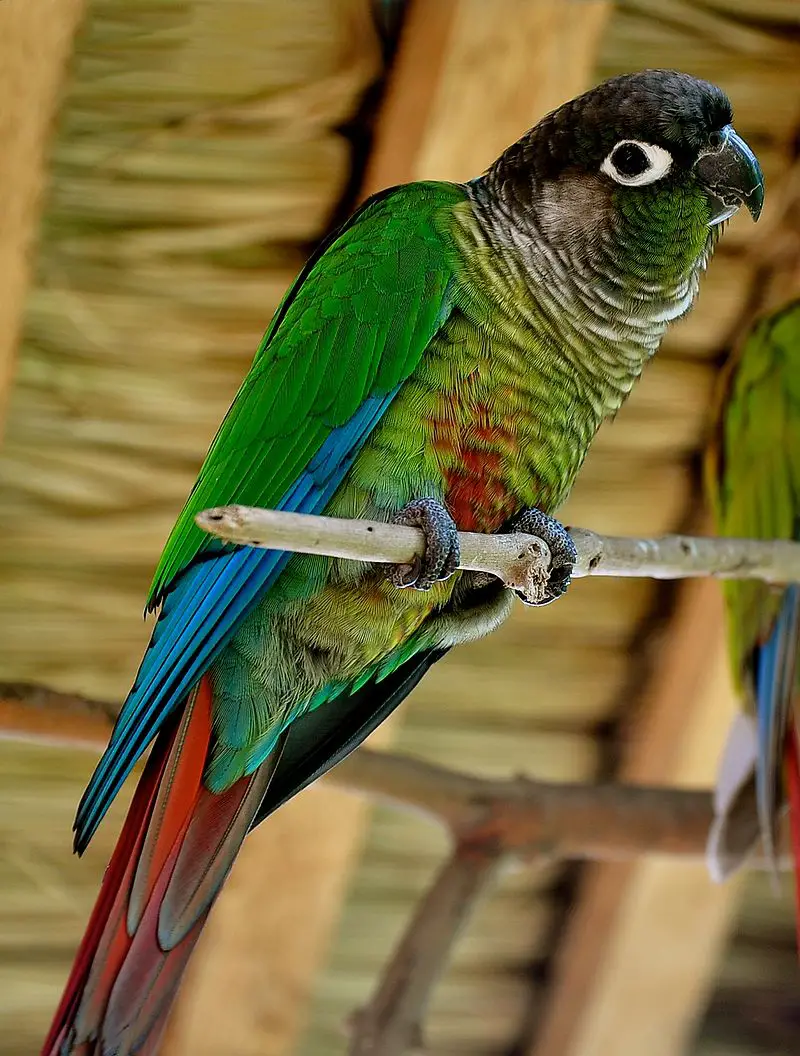
The green-cheeked parakeet is a small and colorful bird native to Central and South America. Also known as the green-cheeked conure, they are part of the long-tailed group of New World parrots from the subfamily Arinae.
These birds have been popular in aviculture for many years due to their bright plumage and playful personalities, making them excellent companion pets.
They can be noisy but also enjoy quiet time with their owners, often cuddling up into one’s neck or shoulder for naps.
Green cheeks require plenty of enrichment activities such as toys, perches and swings in order to stay mentally stimulated; otherwise they may become bored or develop unwanted behaviors.
With proper care these vibrant birds can make amazing lifelong companions.Scientific classification:
| Kingdom | Animalia |
| Phylum | Chordata |
| Class | Aves |
| Order | Psittaciformes |
| Family | Psittacidae |
| Genus | Pyrrhura |
| Species | P. molinae |
38. Resplendent Quetzal
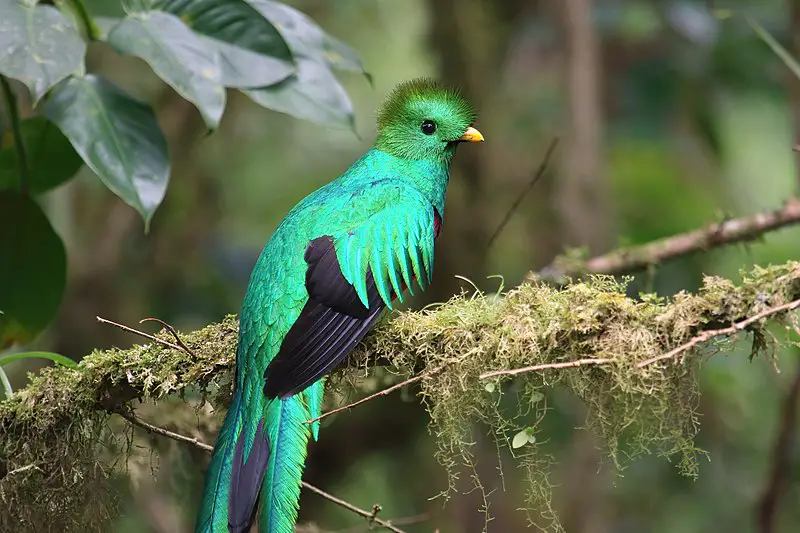
The resplendent quetzal is a beautiful and vibrant bird found in Central America. It belongs to the family Trogonidae, which includes birds like trogons and motmots.
This species of quetzal has two recognized subspecies: P. mocinno and P. costaricensis, both living in tropical forests such as montane cloud forests.
They are omnivores, typically eating fruits from various plants along with insects, lizards or eggs when available.
The male’s plumage is particularly striking with its multi-colored feathers ranging from green to blue to red that gives it its namesake “resplendence” look.
This coloration comes at a price for males because their bright colors make them more visible predators than females who have duller brown coloring instead.
Regardless of gender though all members of this species demonstrate great agility in flight due to their long tails which help stabilize them even through tight turns.Scientific classification:
| Kingdom | Animalia |
| Phylum | Chordata |
| Class | Aves |
| Order | Trogoniformes |
| Family | Trogonidae |
| Genus | Pharomachrus |
| Species | P. mocinno |
39. Buff-Bellied Hummingbird
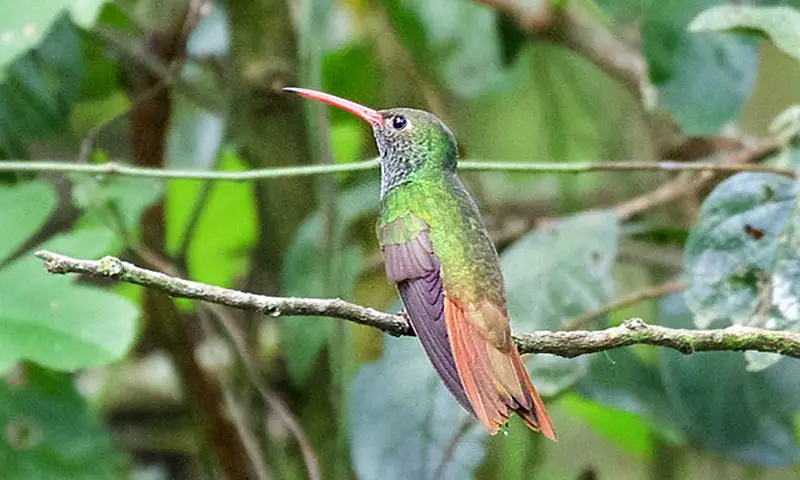
The Buff-bellied Hummingbird is a species of hummingbird belonging to the Trochilini tribe and found in Central America and parts of the United States.
It has three subspecies: A. y. yucatanensis, A. y chalconota, and A.y cerviniventris whose length ranges from 3.9 – 4 inches (10 – 11 cm).
The buff-bellied hummingbird’s plumage is mainly grey with greenish reflections on its back while it sports a distinctive buff colored belly which gives this species its name.
Its diet consists mostly of nectar as well as small insects; they often feed upon flowers near rivers or other bodies of water where their preferred food sources are plentiful.
In addition to being quite beautiful birds, these delightful creatures also possess an impressive ability for hovering flight making them one of nature’s most graceful avian wonders.Scientific classification:
| Kingdom | Animalia |
| Phylum | Chordata |
| Class | Aves |
| Order | Apodiformes |
| Family | Trochilidae |
| Genus | Amazilia |
| Species | A. yucatanensis |
40. Aratinga
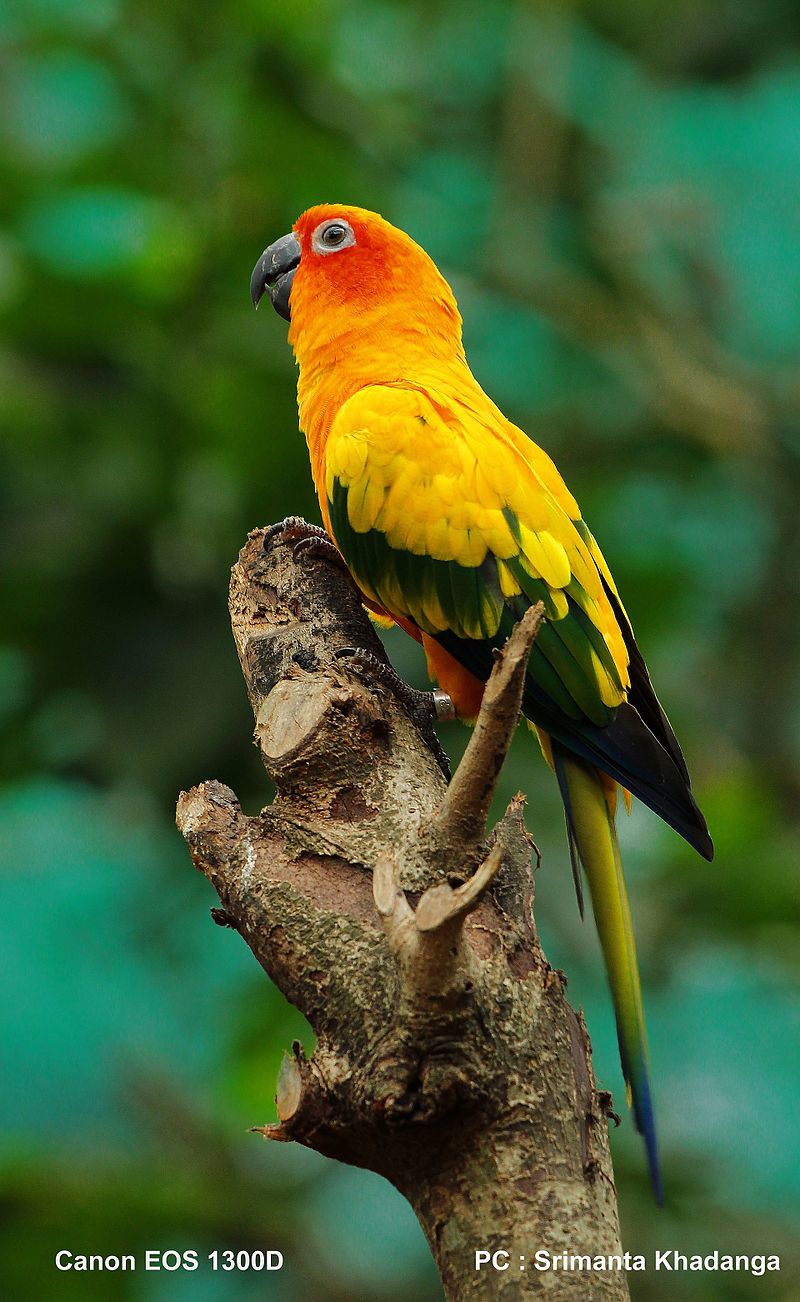
Aratinga is a genus of South American conures that are known for their vibrant colors and friendly nature.
Most have feathers that are predominantly green, but some species may also be yellow or orange in color.
These birds live in large flocks and can often be seen flying around together in the wild.
In Brazil, many members of this genus go by the name “jandaia.” These stunning birds make great pets due to their social personalities and beautiful features.
They’re larger than most other pet parrots but still small enough to manage easily as long as they get adequate exercise each day.
Aratingas require plenty of mental stimulation too – interactive toys such as puzzles or those with hidden treats will keep them engaged while keeping boredom at bay.Scientific classification:
| Kingdom | Animalia |
| Phylum | Chordata |
| Class | Aves |
| Order | Psittaciformes |
| Family | Psittacidae |
| Tribe | Arini |
| Genus | Aratinga Spix, 1824 |
41. Nanday Parakeet
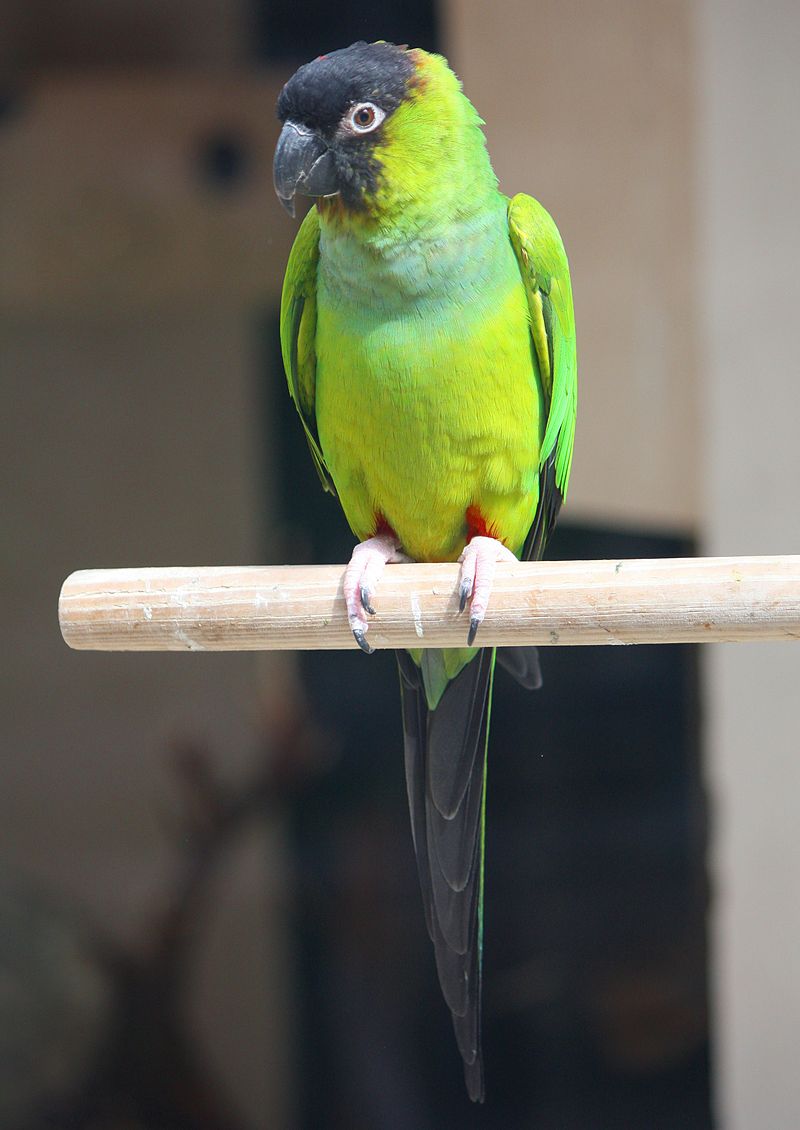
The Nanday Parakeet is a medium-small, mostly green Neotropical parrot native to South America. It has a distinctive black hood that covers its head and neck area.
This bird is known for its intelligence and playful nature which makes it an ideal pet in many homes.
Its diet consists of fruits, seeds, buds, flowers, nuts and occasionally insects making it easy to feed at home or outside the home environment.
The Nanday Parakeet can live up to 30 years with proper care so having one as a companion means you can enjoy their company for decades.
They are also very social birds who love interacting with people and other pets – perfect if you want some extra companionship in your life.Scientific classification:
| Kingdom | Animalia |
| Phylum | Chordata |
| Class | Aves |
| Order | Psittaciformes |
| Family | Psittacidae |
| Genus | Aratinga |
| Species | A. nenday |
42. Anna’s Hummingbird
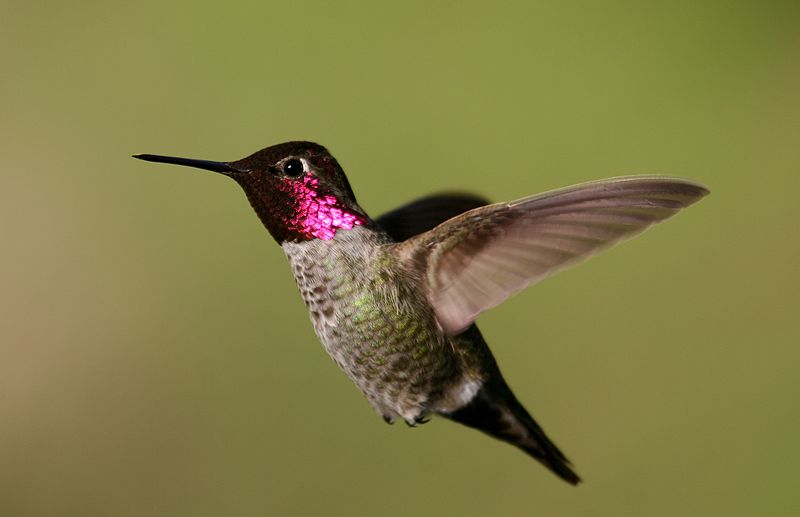
Anna’s hummingbird is a beautiful species of bird belonging to the Trochilidae family. Native to western coastal regions of North America, it was named after Anna Masséna, Duchess of Rivoli.
In the early 20th century, these birds bred only in northern Baja California and southern California but due to ornamental plant transplanting they can now be found across much of Pacific Coast region.
They are medium-sized with bright emerald green feathers on their back and crowns as well as rose-red patches at the throat for males which makes them quite distinguishable from other birds.
Their diet consists mainly nectar from flowers although they will occasionally feed on insects or spiders too making them important pollinators that help maintain healthy ecosystems.Scientific classification:
| Kingdom | Animalia |
| Phylum | Chordata |
| Class | Aves |
| Order | Apodiformes |
| Family | Trochilidae |
| Genus | Calypte |
| Species | C. anna |
43. Rivoli’s Hummingbird
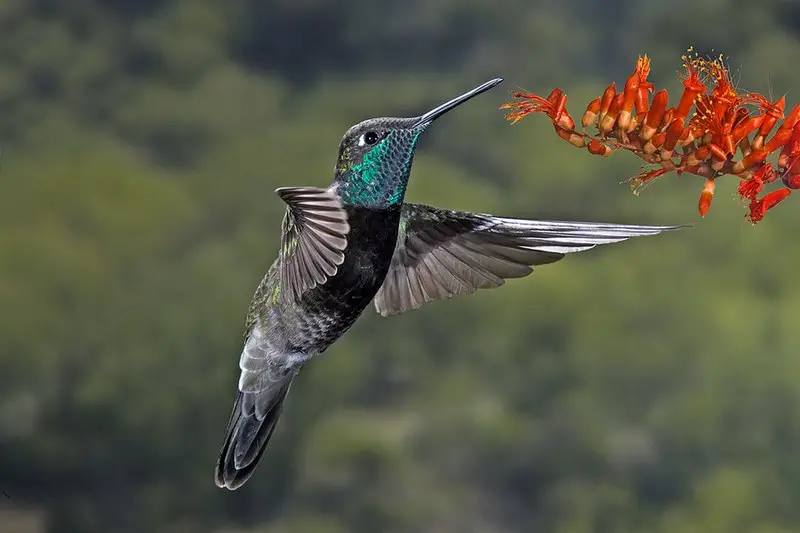
Rivoli’s hummingbird is a beautiful species of bird found in Central and North America. It belongs to the family Trochilinae, also known as “mountain gems”.
The male has an impressive iridescent purple-blue head and throat with greenish back, while the female has a more subdued coloring.
One unique feature about this species is its long tail feathers which can be up to twice as long as its body length.
This amazing bird feeds on nectar from flowers and insects such as midges, mosquitoes, spiders and moths; they even feed on sap from trees too.
Rivoli’s Hummingbirds are active during the day when their spectacular colors shine brightest making them easy to spot among other birds.
These tiny yet fascinating creatures provide us with endless hours of entertainment – it’s no wonder why they have been so adored over time.Scientific classification:
| Kingdom | Animalia |
| Phylum | Chordata |
| Class | Aves |
| Order | Apodiformes |
| Family | Trochilidae |
| Genus | Eugenes |
| Species | E. fulgens |
44. Pacific-Slope Flycatcher
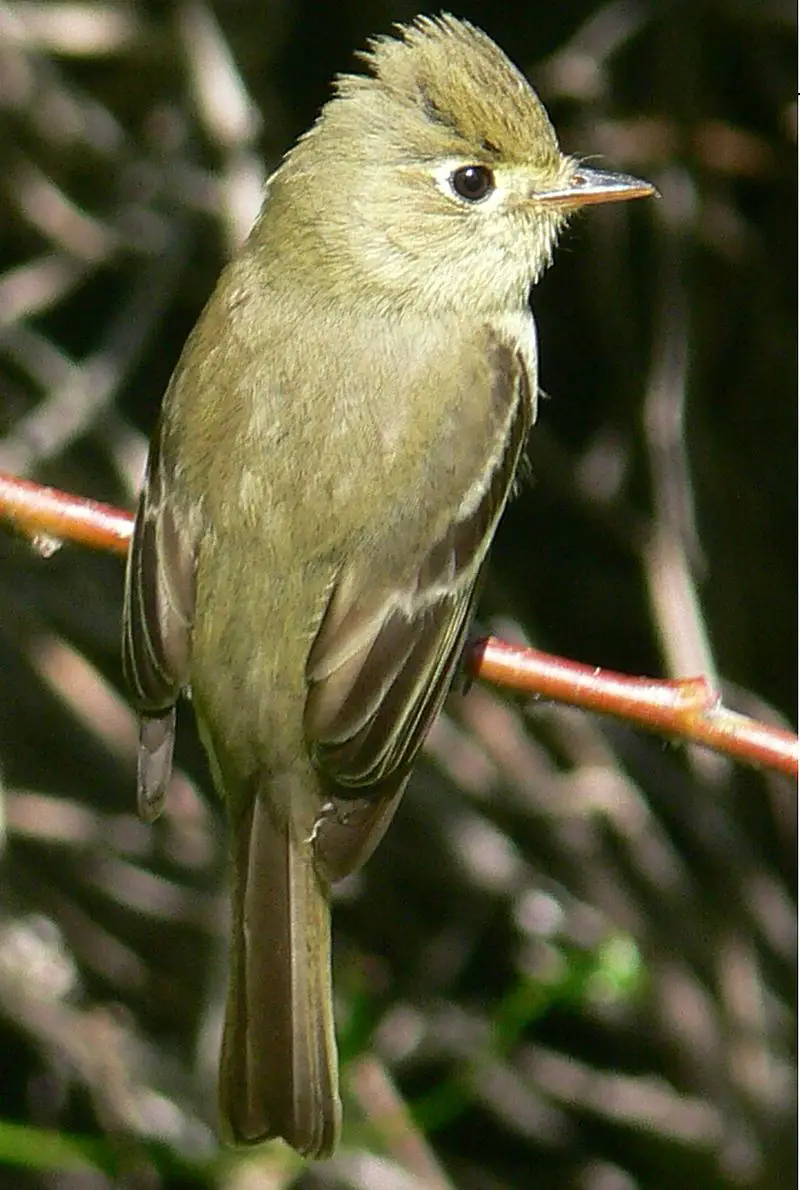
The Pacific-slope flycatcher is a small insectivorous bird of the family Tyrannidae, native to coastal regions in western North America.
It ranges from British Columbia and southern Alaska down to the Gulf of California and beyond, as far south as Central America.
The adult male has olive-green upperparts with yellowish underparts while females tend to be more dull and brownish overall. This species can also be distinguished by its clear white wing bars on both sides of each wing.
They are commonly found near streams or rivers around wooded areas foraging for insects such as flies, mosquitoes, moths and beetles which make up their diet along with some berries when available during certain times of year.
Its presence can often alert other birds that it may have spotted potential predators nearby due to its loud ‘chip’ call typically made when alarmed or agitated.Scientific classification:
| Kingdom | Animalia |
| Phylum | Chordata |
| Class | Aves |
| Order | Passeriformes |
| Family | Tyrannidae |
| Genus | Empidonax |
| Species | E. difficilis |
45. Great Green Macaw
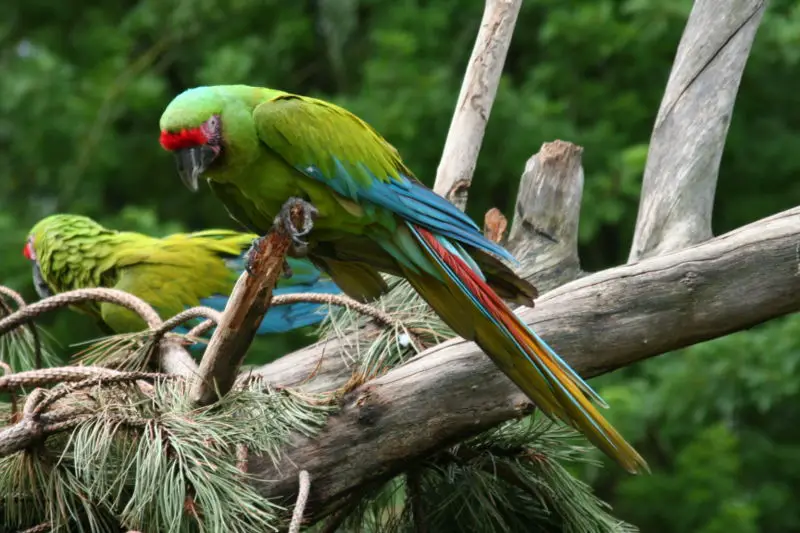
The great green macaw is a beautiful Central and South American parrot that can be found from Honduras to Colombia as well as Nicaragua, Costa Rica, Panama, and Ecuador.
With its bright red forehead, yellow cheeks and blue wings it’s easy to spot in the wild.
This magnificent bird has two recognized subspecies; Ara ambiguus ssp. ambiguus which ranges across most of its range while Ara ambiguus ssp. guayaquilensis appears exclusive to northwestern Ecuador.
These birds are usually seen foraging for seeds but their diet also includes fruits such as figs or palm nuts making them an important part of tropical ecosystems.Scientific classification:
| Kingdom | Animalia |
| Phylum | Chordata |
| Class | Aves |
| Order | Psittaciformes |
| Family | Psittacidae |
| Genus | Ara |
| Species | A. ambiguus |
46. Eclectus Parrot
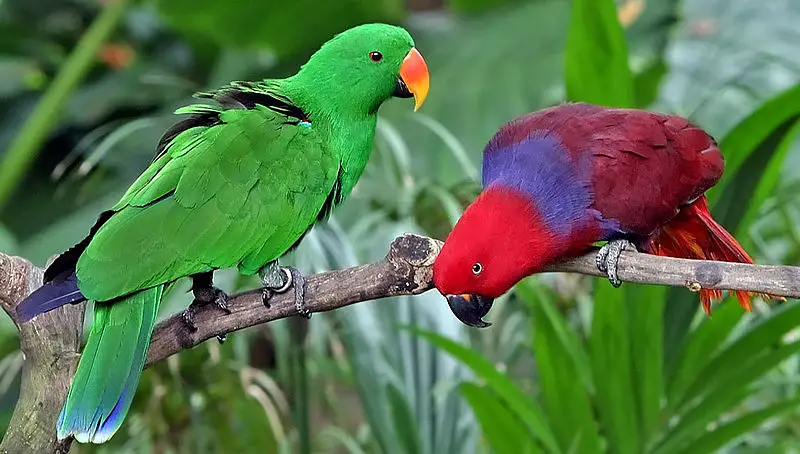
The eclectus parrot is a unique species of bird due to its extreme sexual dimorphism in plumage coloration.
The males have bright emerald green feathers while the females can be seen with vibrant red and purple/blue colors.
It’s natively found from Solomon Islands, Sumba, New Guinea, northeastern Australia and Maluku Islands (Moluccas).
This beautiful parrot has an average lifespan of 30 years in captivity if given proper care and nutrition.
They’re known for their intelligence; they require lots of mental stimulation through playtime as well as physical exercise opportunities to stay healthy both mentally & physically.
Overall this gorgeous bird makes a great pet but needs plenty of attention and dedication.Scientific classification:
| Kingdom | Animalia |
| Phylum | Chordata |
| Class | Aves |
| Order | Psittaciformes |
| Family | Psittaculidae |
| Genus | Eclectus |
| Species | E. roratus |
47. Green-Winged Teal
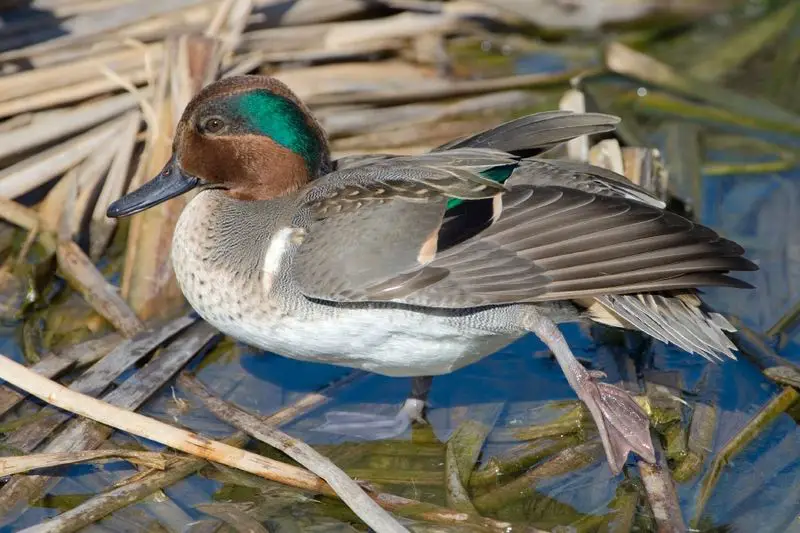
The green-winged teal is a common and widespread duck that can be found across most of North America, except for the Aleutian Islands.
It was once thought to belong to the same species as Eurasian teals but has since been classified differently by many authorities.
These small ducks have colorful wings which display shades of green and blue along with buffy brown coloration on their undersides.
The male birds are particularly striking during mating season when they acquire beautiful chestnut markings on their heads and upper breasts.
They feed mainly in shallow water bodies such as ponds, lakes, marshes or estuaries, eating aquatic invertebrates like snails or insects.
When disturbed they can fly away rapidly with a loud whistling sound produced by their wings during flight.Scientific classification:
| Kingdom | Animalia |
| Phylum | Chordata |
| Class | Aves |
| Order | Anseriformes |
| Family | Anatidae |
| Genus | Anas |
| Species | A. carolinensis |
Also Featured In: Phoenix Birds You Should Know, Wetlands Birds You Should Know
48. White-Cheeked Turaco
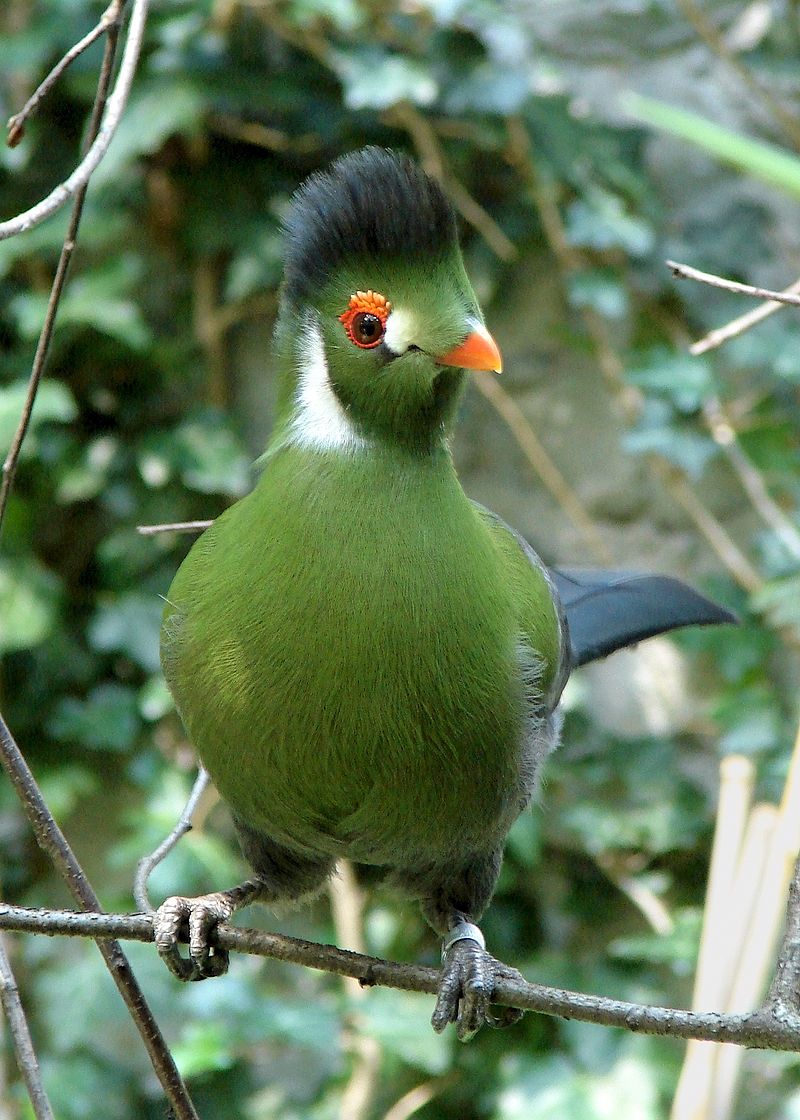
The White-cheeked Turaco is a large and vibrant bird that can be found in Eritrea, Ethiopia and South Sudan.
It has a long tail measuring around 19cm (7.5in) making it approximately 43 cm (17in) in length overall with an average weight of 200–315g (7.1–11.1oz).
They are distinguished by their bright red eyes, white cheeks and glossy green feathers often accompanied by black markings on the wings and back giving them a stunning appearance.
This species is also one of the most commonly kept turacos in captivity due to its wonderful colours which make it quite popular as an exotic pet or showbird.
Its diet mainly consists of fruits, insects, seeds and leaves providing plenty of nutrition for this magnificent creature.Scientific classification:
| Kingdom | Animalia |
| Phylum | Chordata |
| Class | Aves |
| Order | Musophagiformes |
| Family | Musophagidae |
| Genus | Menelikornis |
| Species | M. leucotis |
49. Ruby-Throated Hummingbird

The ruby-throated hummingbird (Archilochus colubris) is a species of hummingbird that has an impressive migration pattern, spending the winter in Central America, Mexico and Florida before flying to Canada and other parts of Eastern North America for breeding season.
It’s by far the most common type seen east of the Mississippi River in North America.
Formally described by Swedish naturalist Carl Linnaeus in 1758, this tiny bird has bright metallic green upperparts with white underparts, a small black bill and a red throat patch which gives it its name; they measure around 3 inches long on average.
They feed primarily on nectar from flowers but also eat insects such as flies or mosquitoes for extra protein during their migrations or when raising young chicks.Scientific classification:
| Kingdom | Animalia |
| Phylum | Chordata |
| Class | Aves |
| Order | Apodiformes |
| Family | Trochilidae |
| Genus | Archilochus |
| Species | A. colubris |
50. Green Catbird
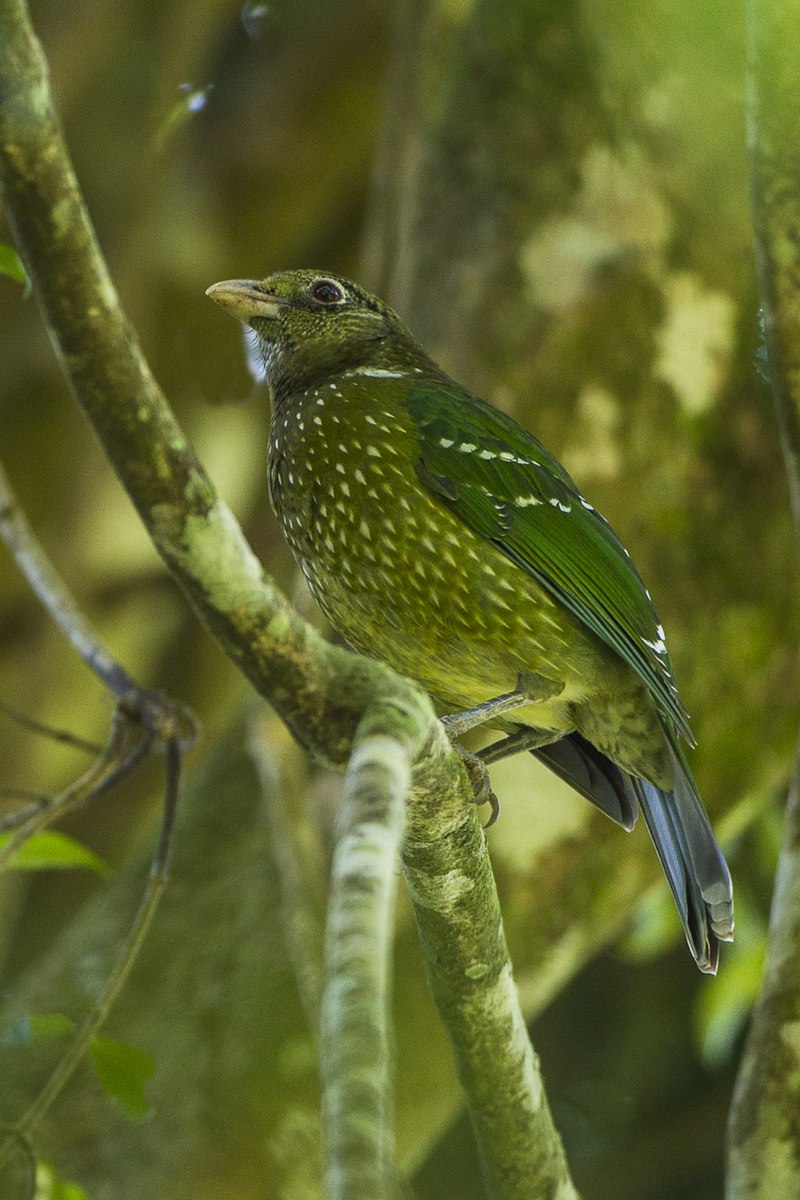
The Green Catbird is an attractive bird native to the east coast of Australia, from southeastern Queensland to southern New South Wales.
It has a striking olive green body with darker wings and tail feathers, as well as yellow eyes and bill.
Its most distinguishing trait however is its call which sounds like a meowing cat or crying child.
The species can be found in subtropical forests where it builds a bower consisting of sticks and leaves for displaying items such as shells, berries and flowers.
These birds feed mainly on fruits but also take insects during breeding season when they need extra protein to support their young chicks.
All in all, this charming little bird may not have the brightest plumage around but it’s certainly one of the sweetest sounding.Scientific classification:
| Kingdom | Animalia |
| Phylum | Chordata |
| Class | Aves |
| Order | Passeriformes |
| Family | Ptilonorhynchidae |
| Genus | Ailuroedus |
| Species | A. crassirostris |
Also Featured In: Birds Typically Found in Australian Rainforest,